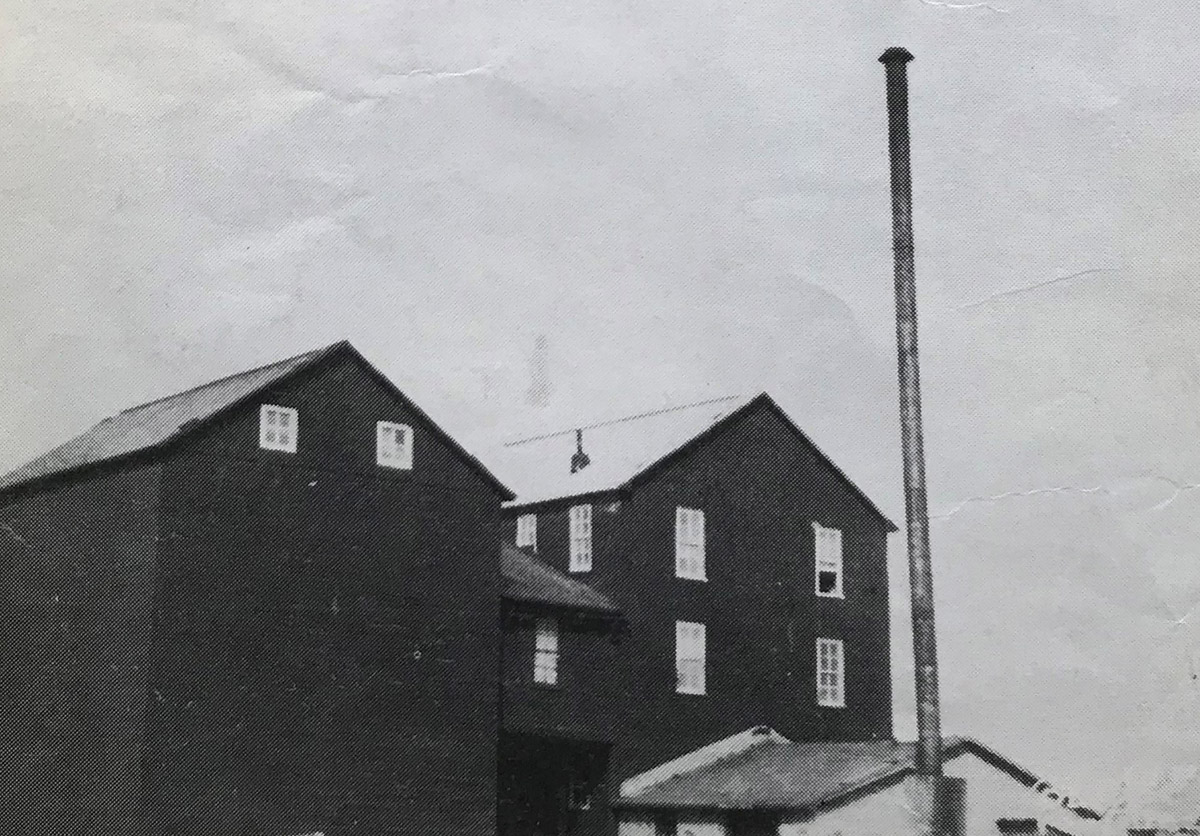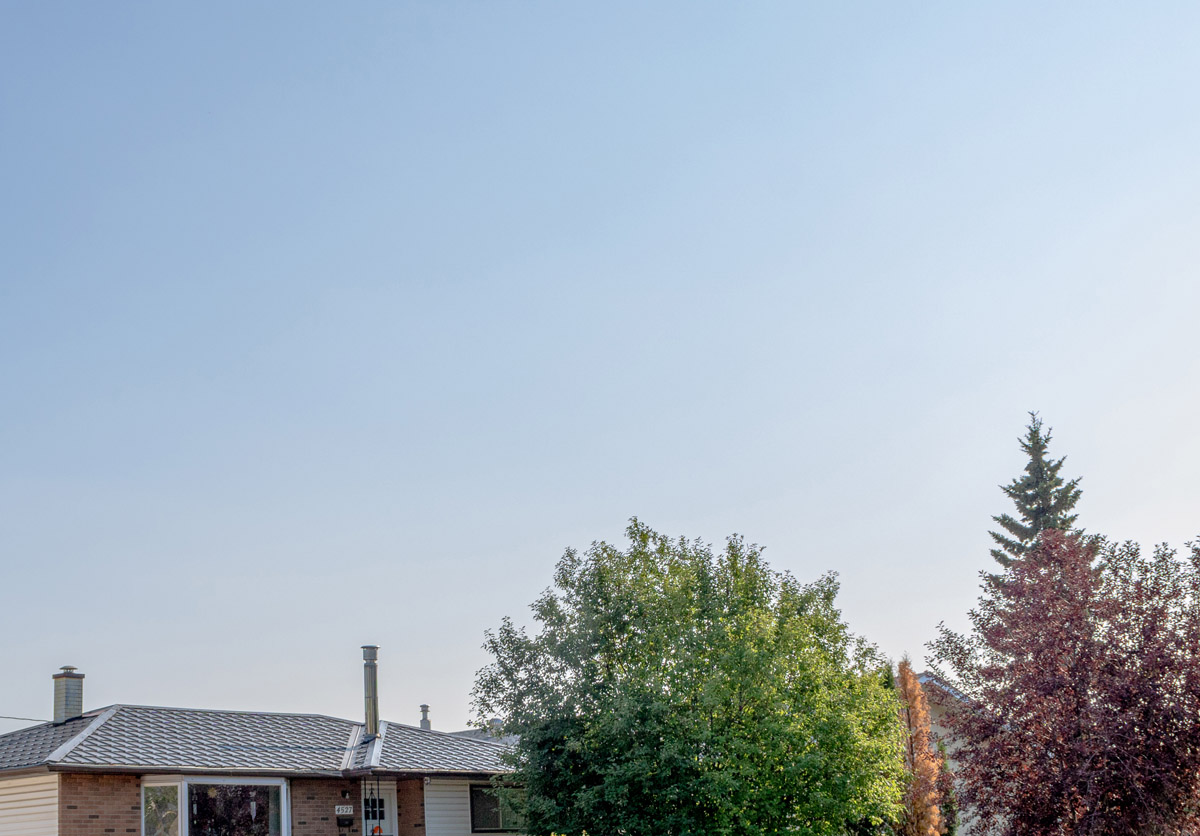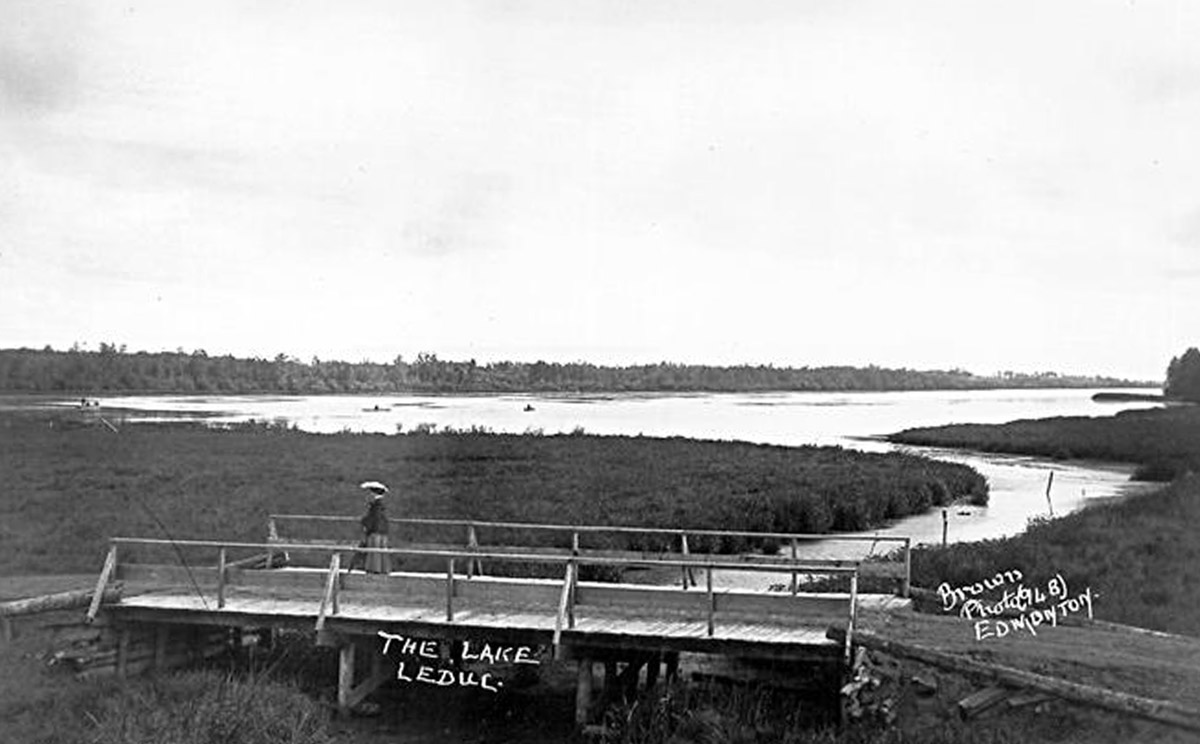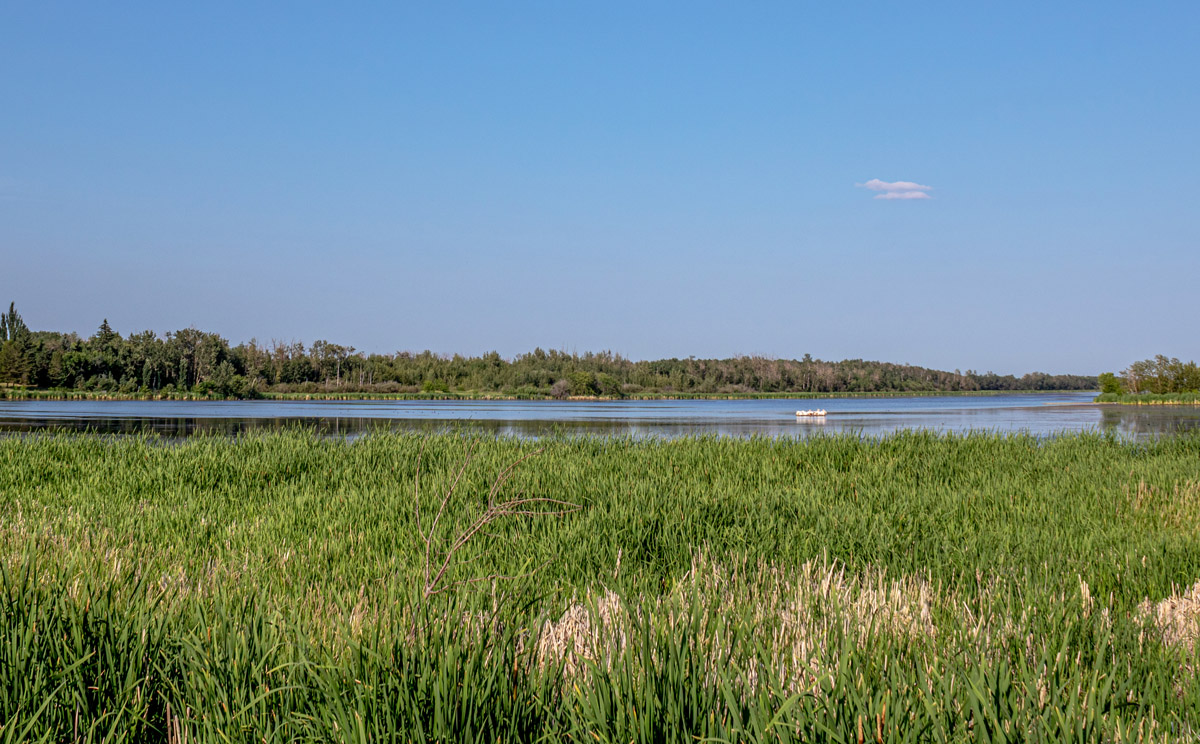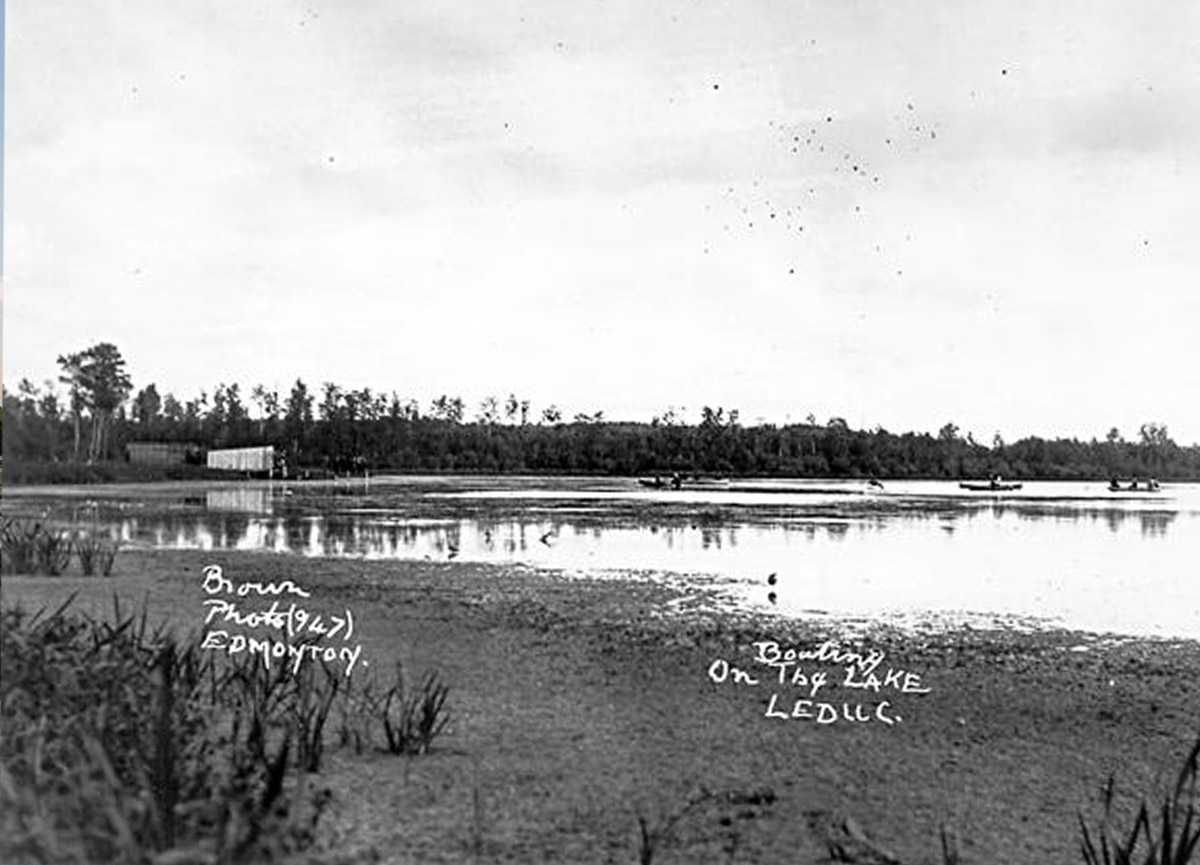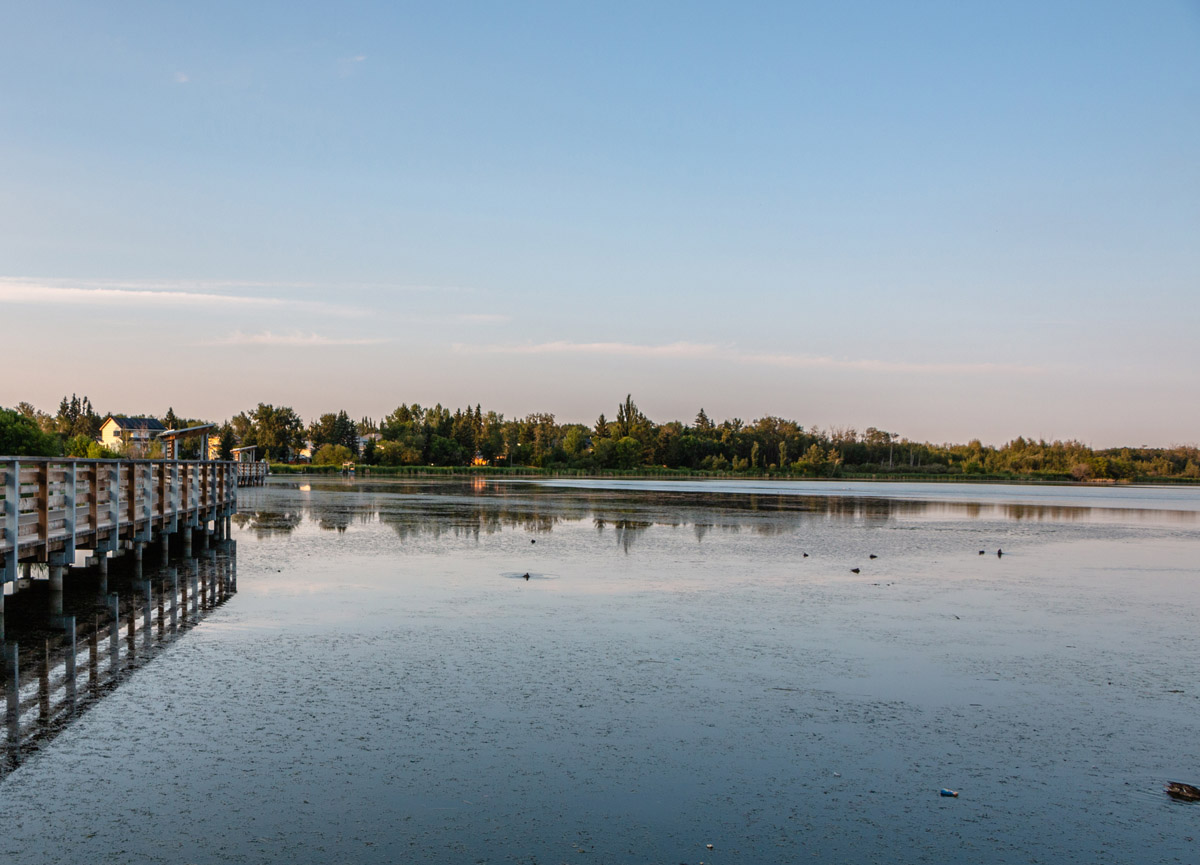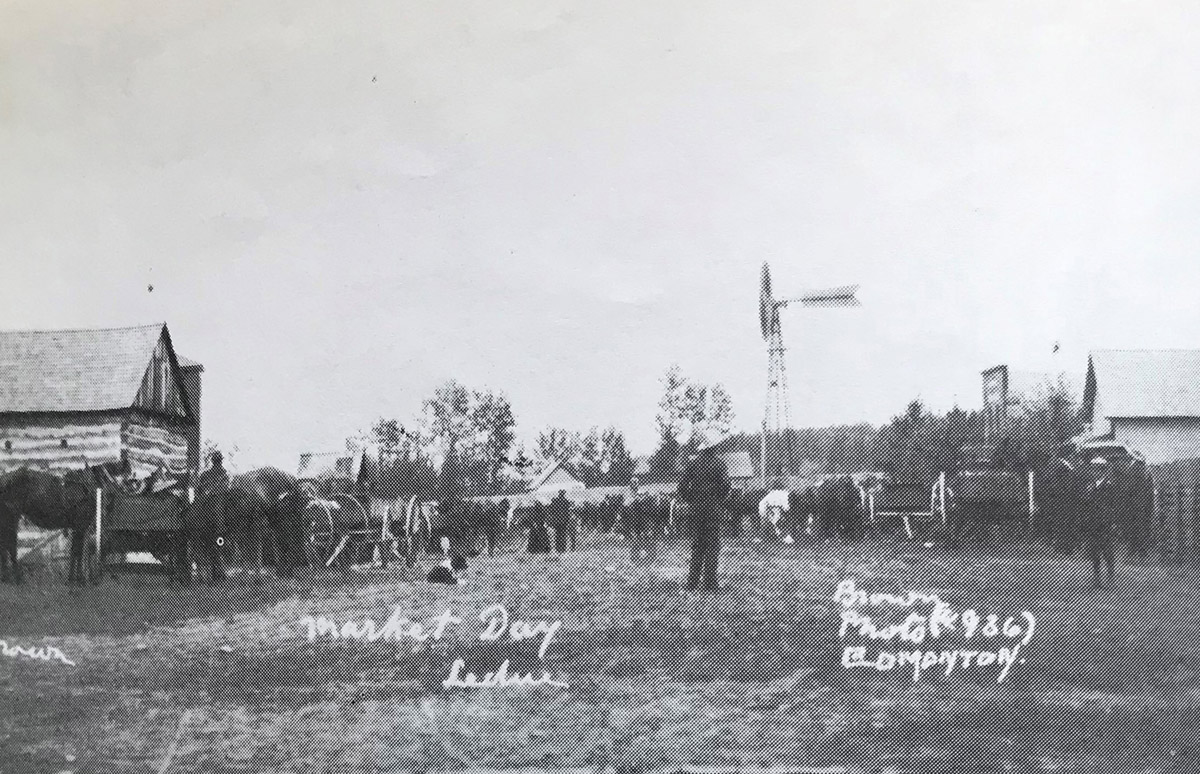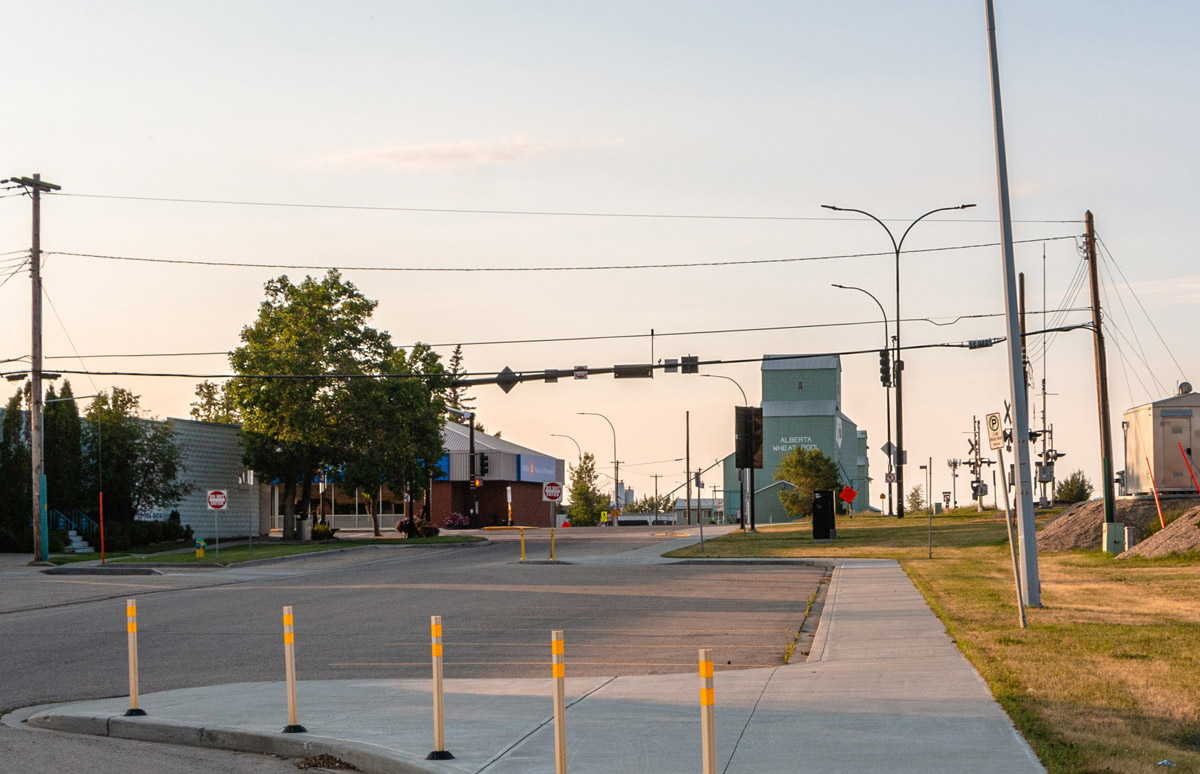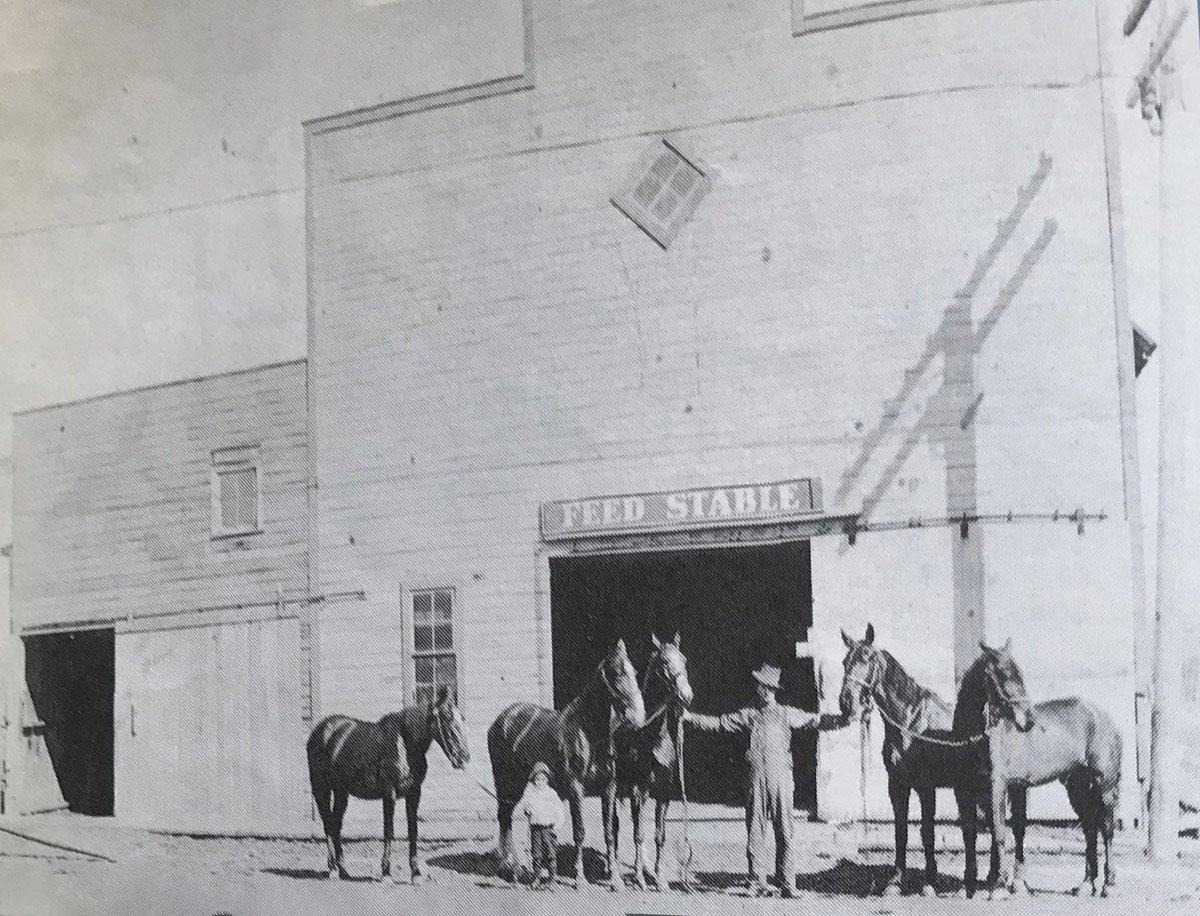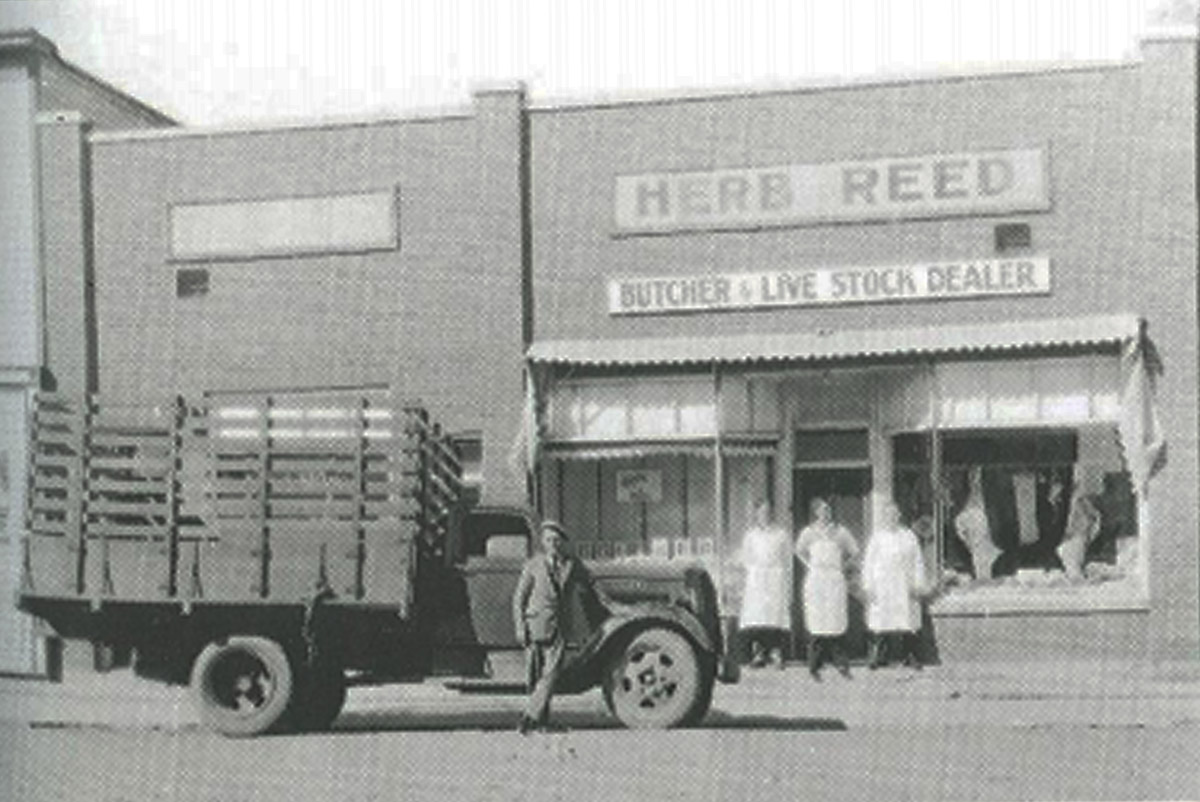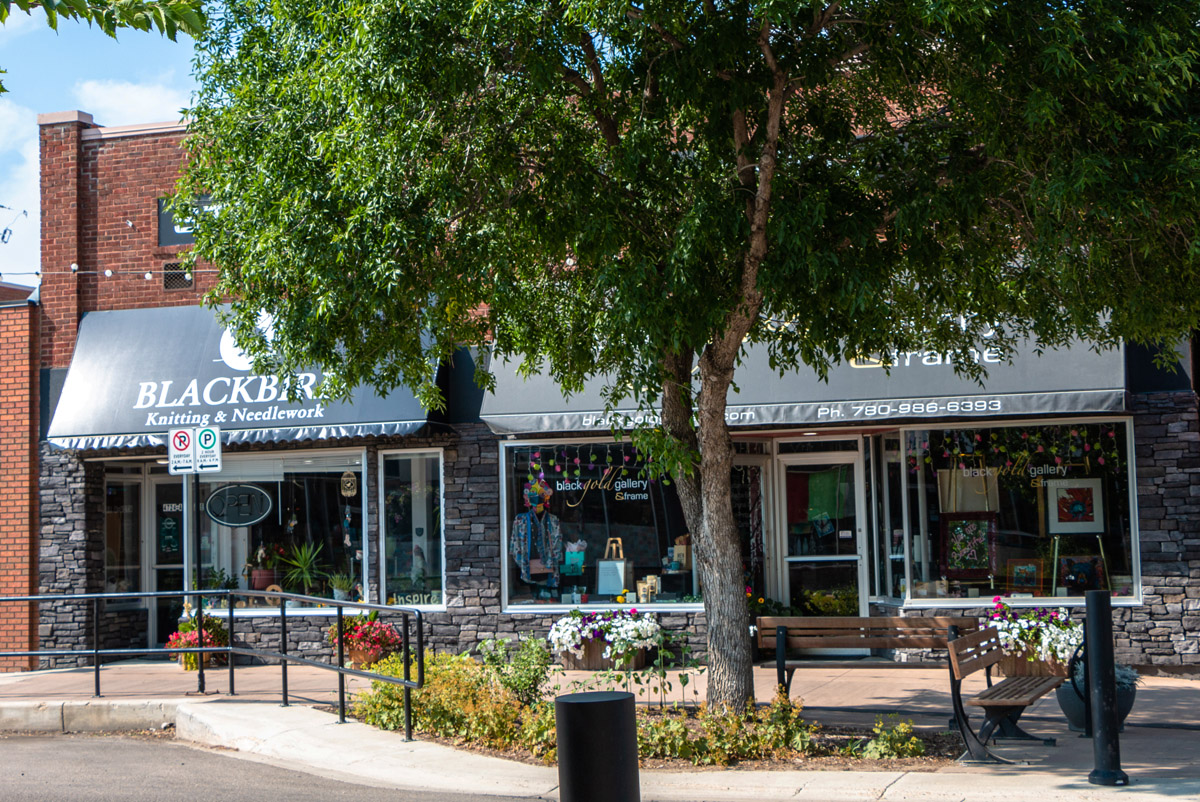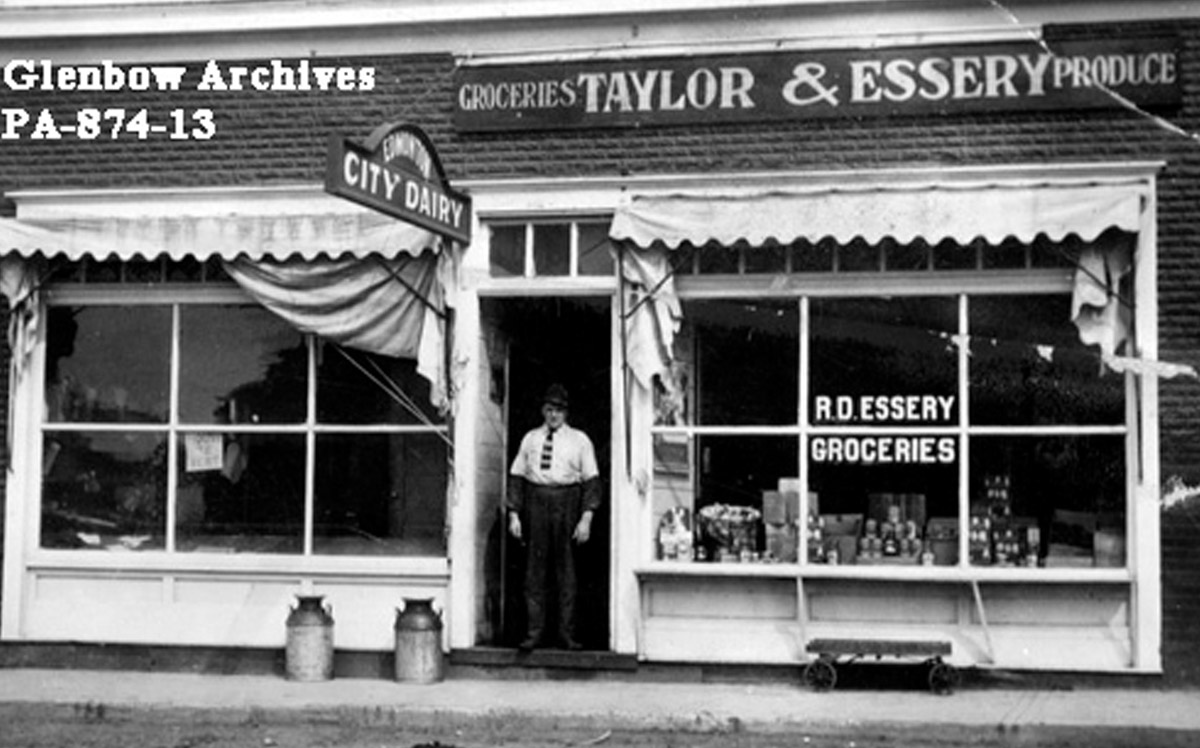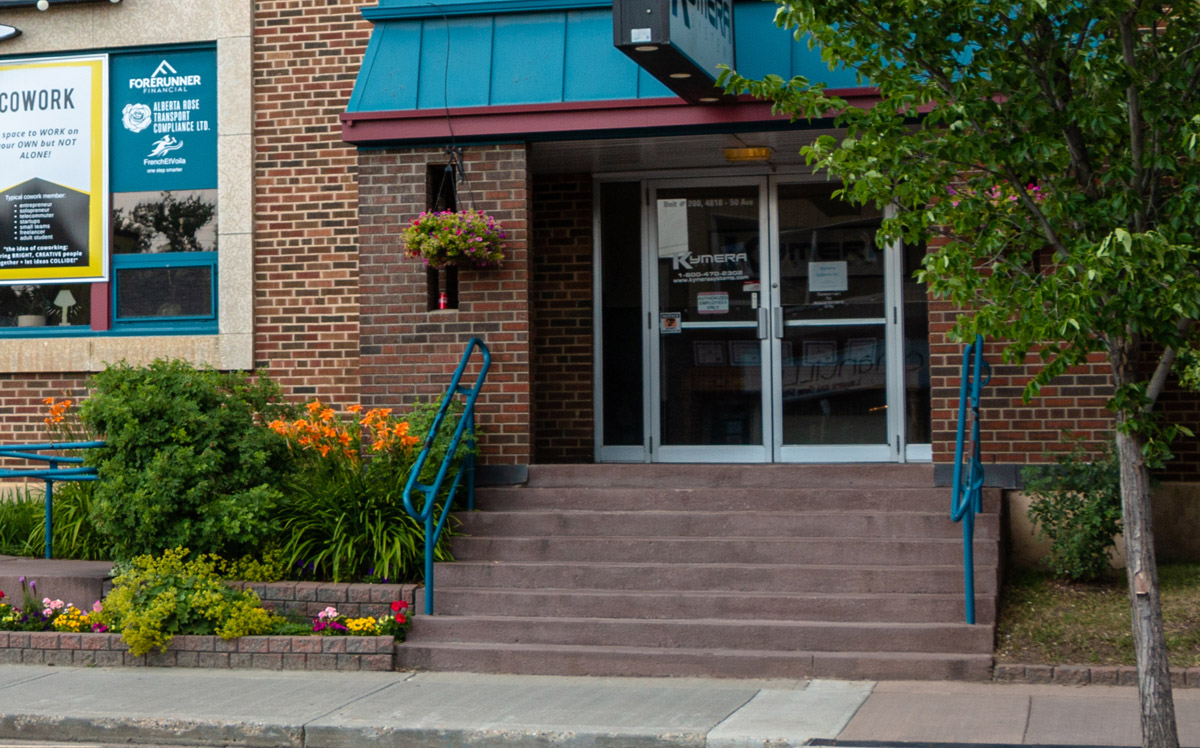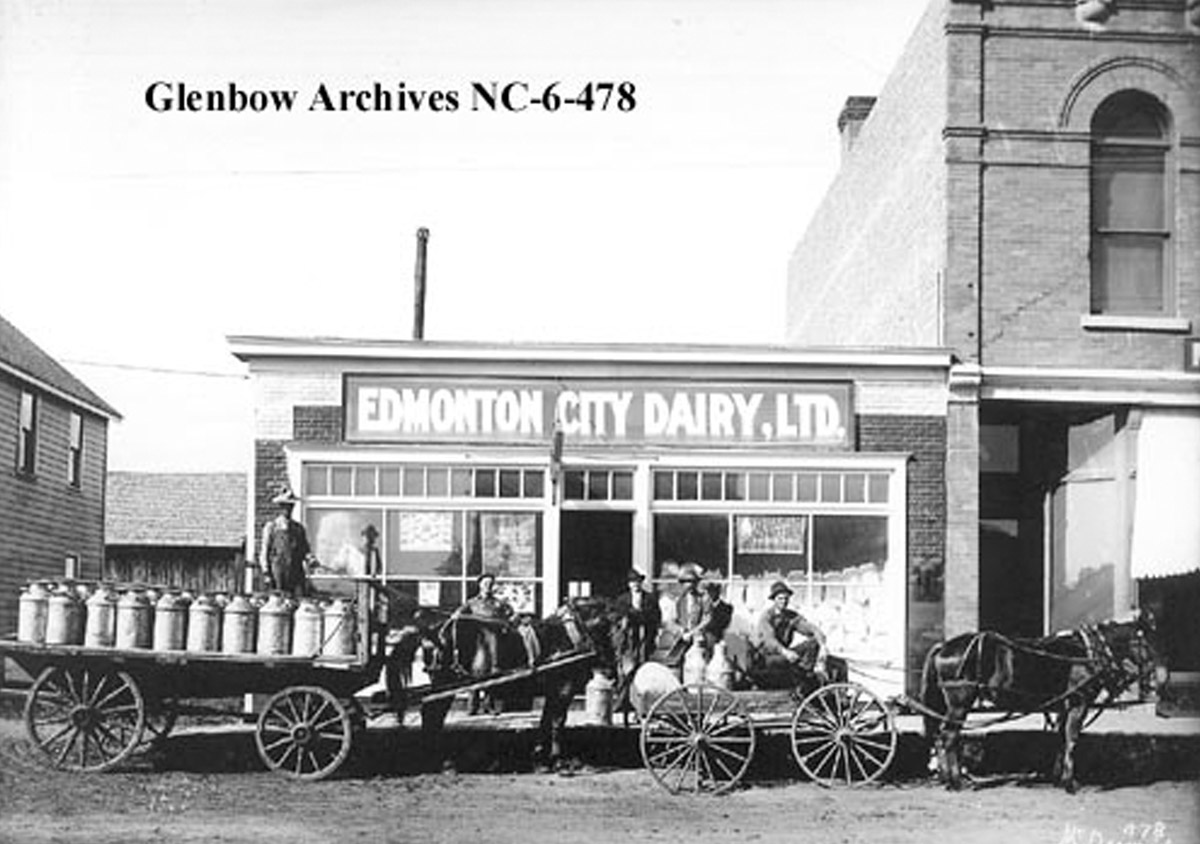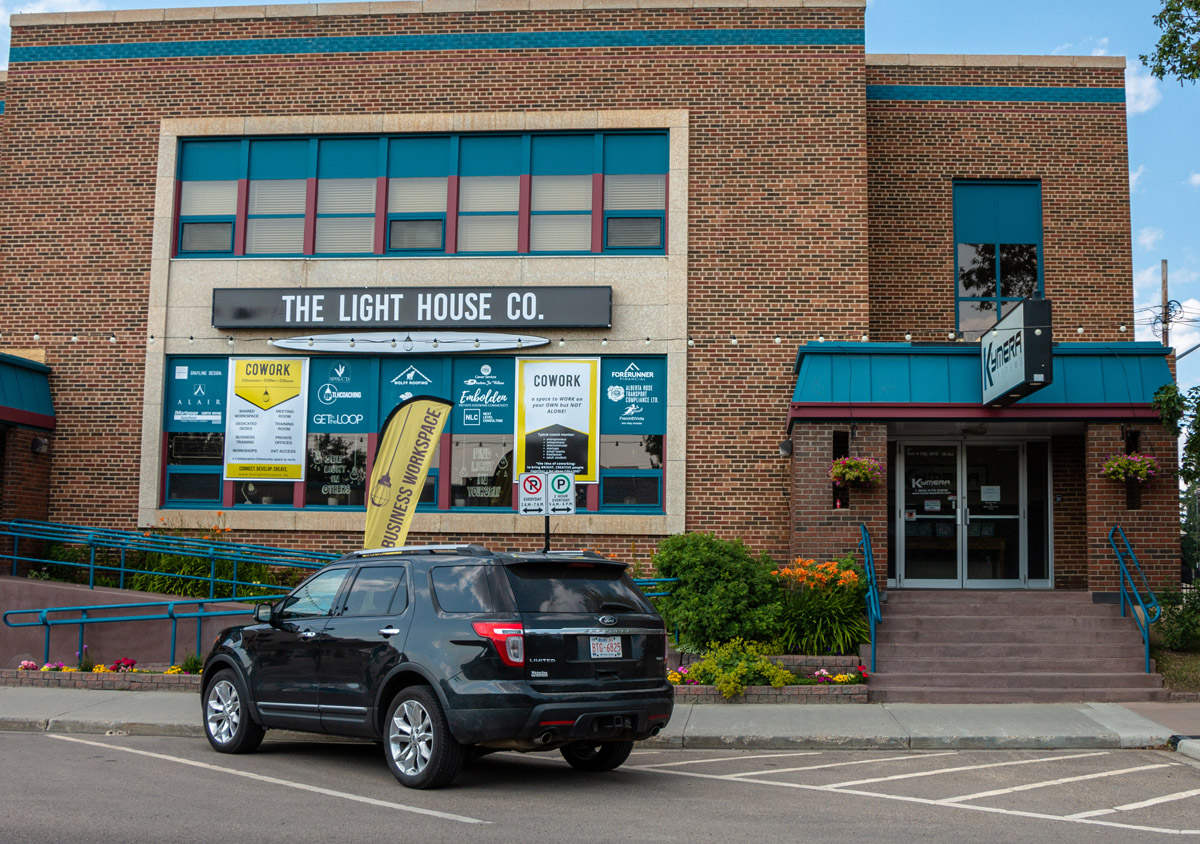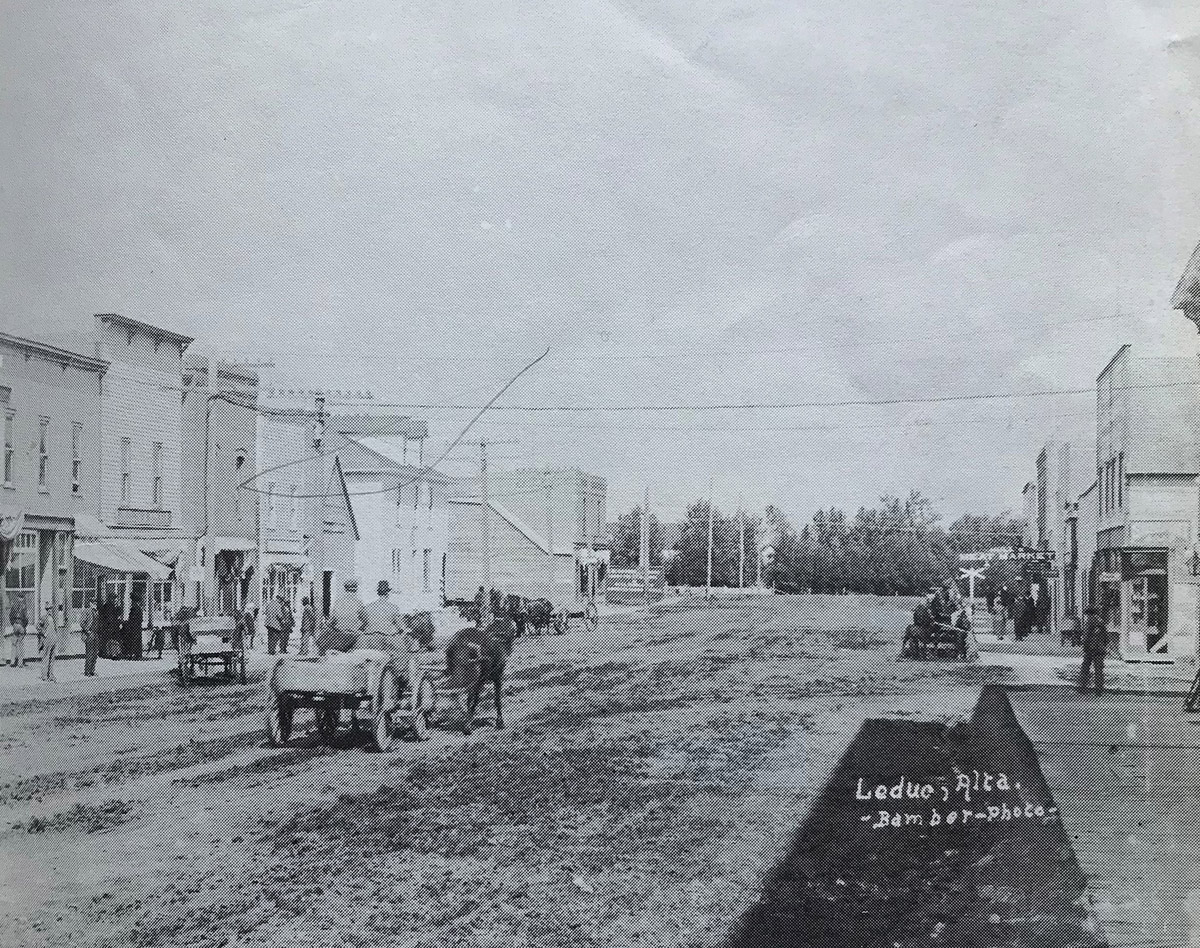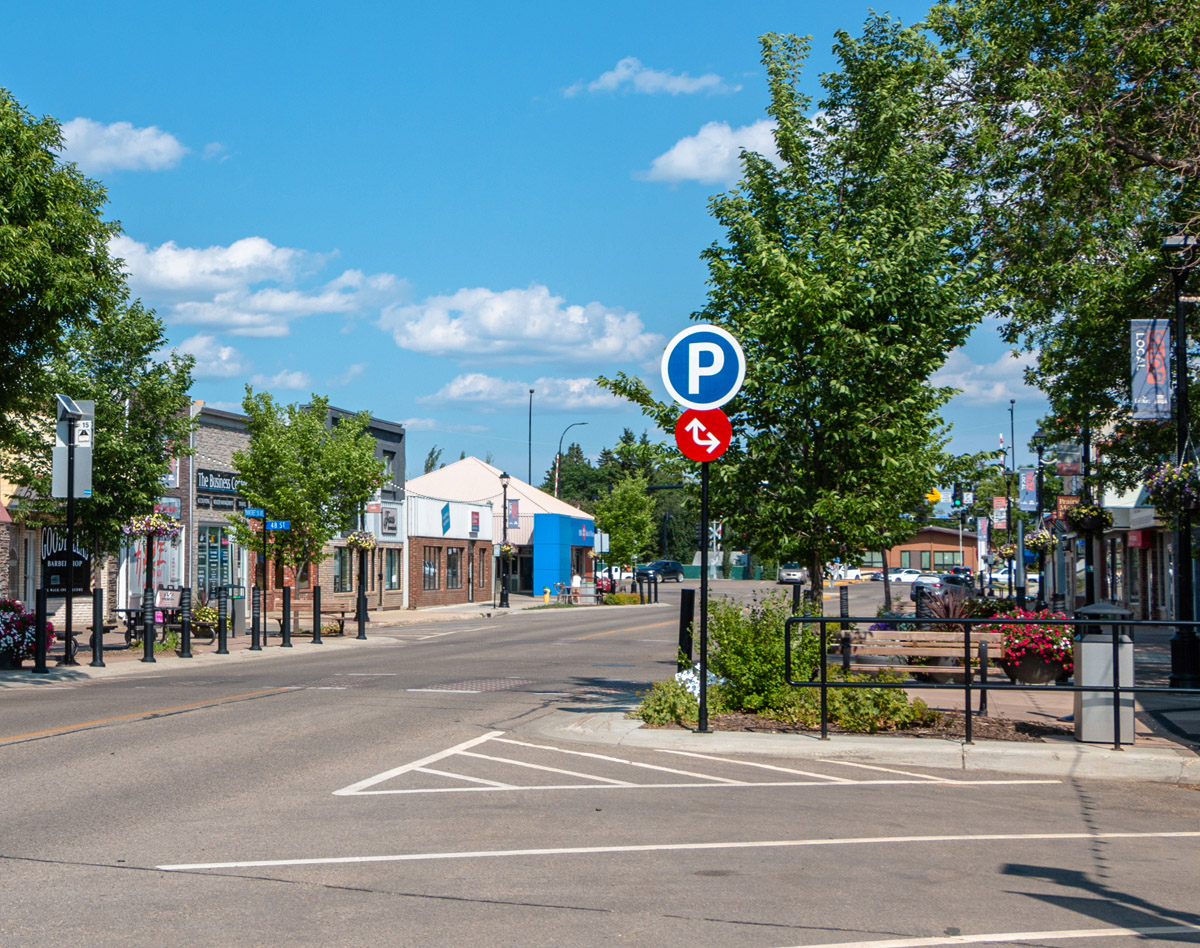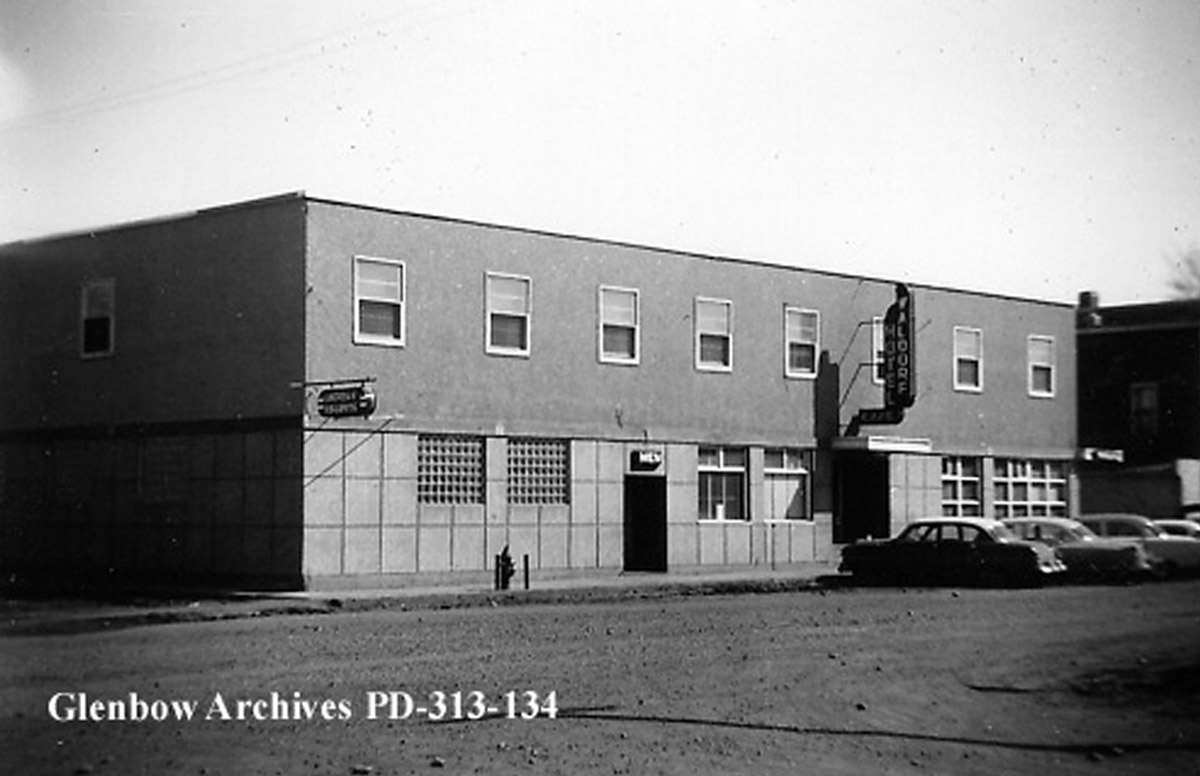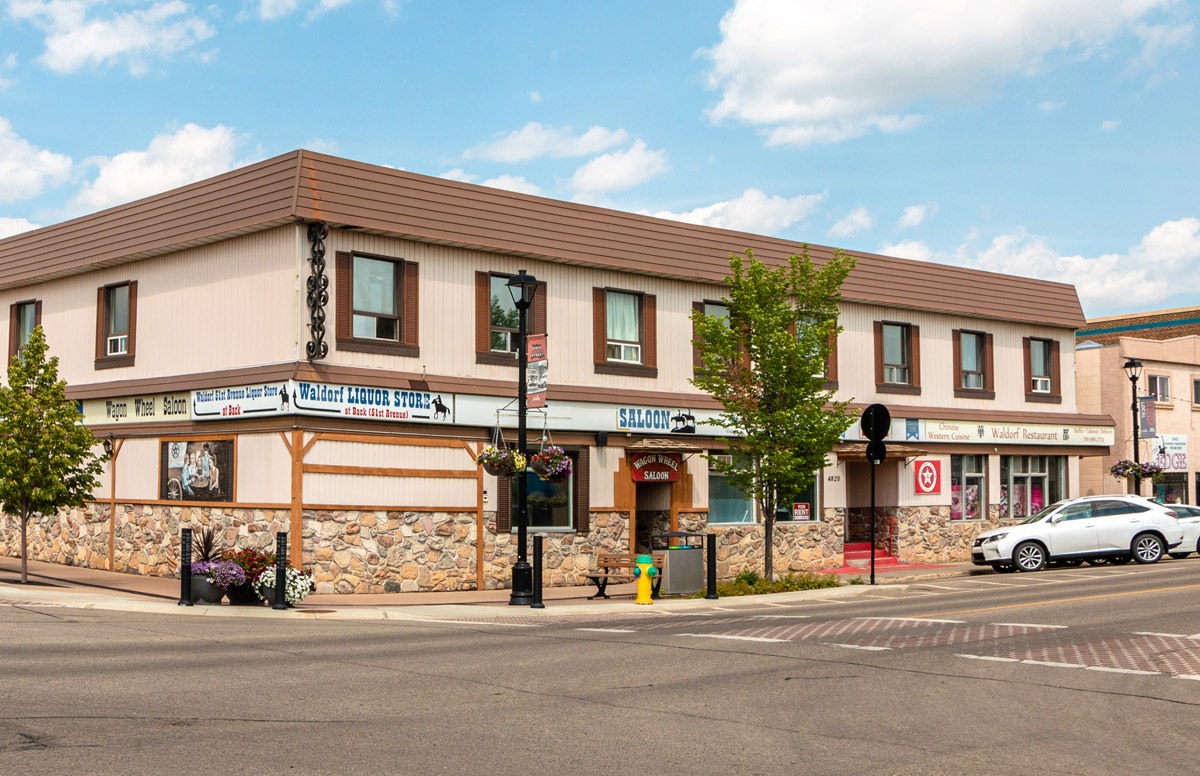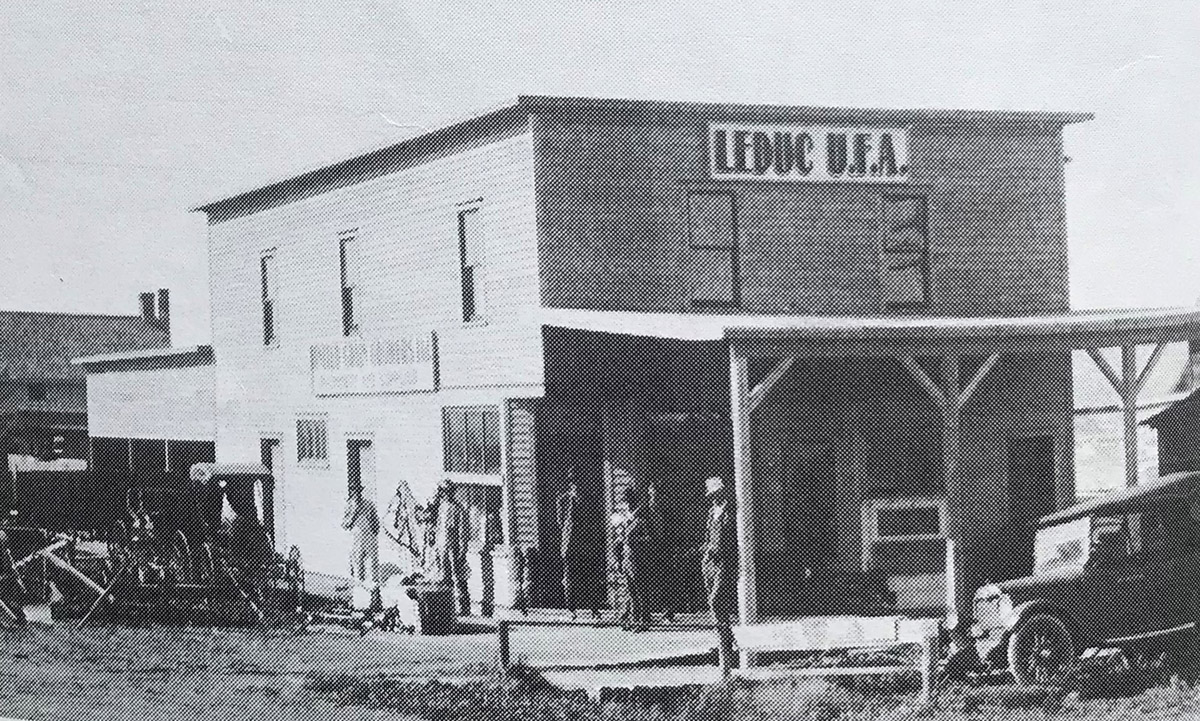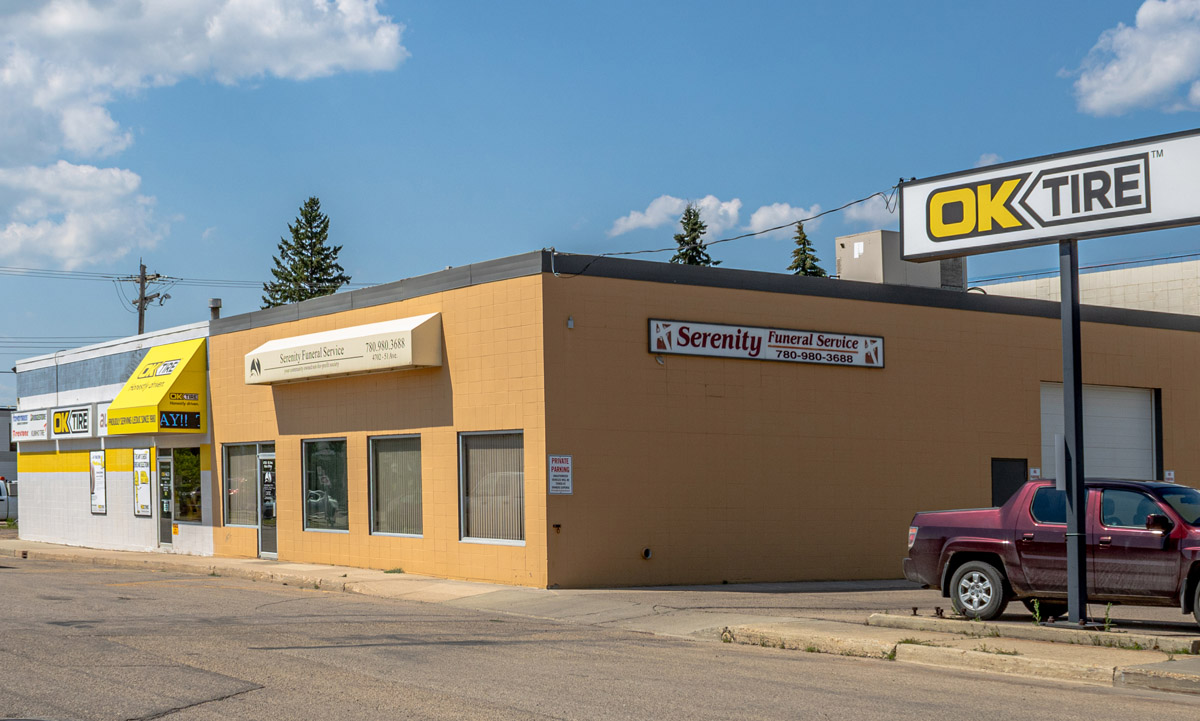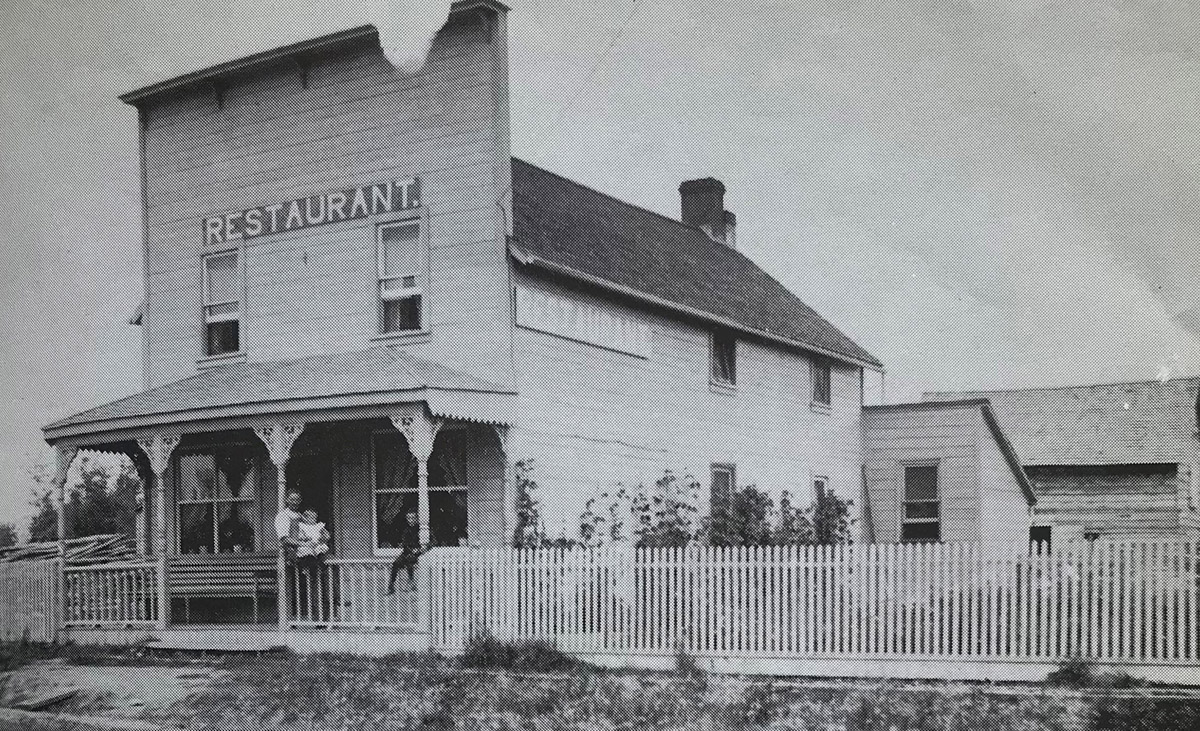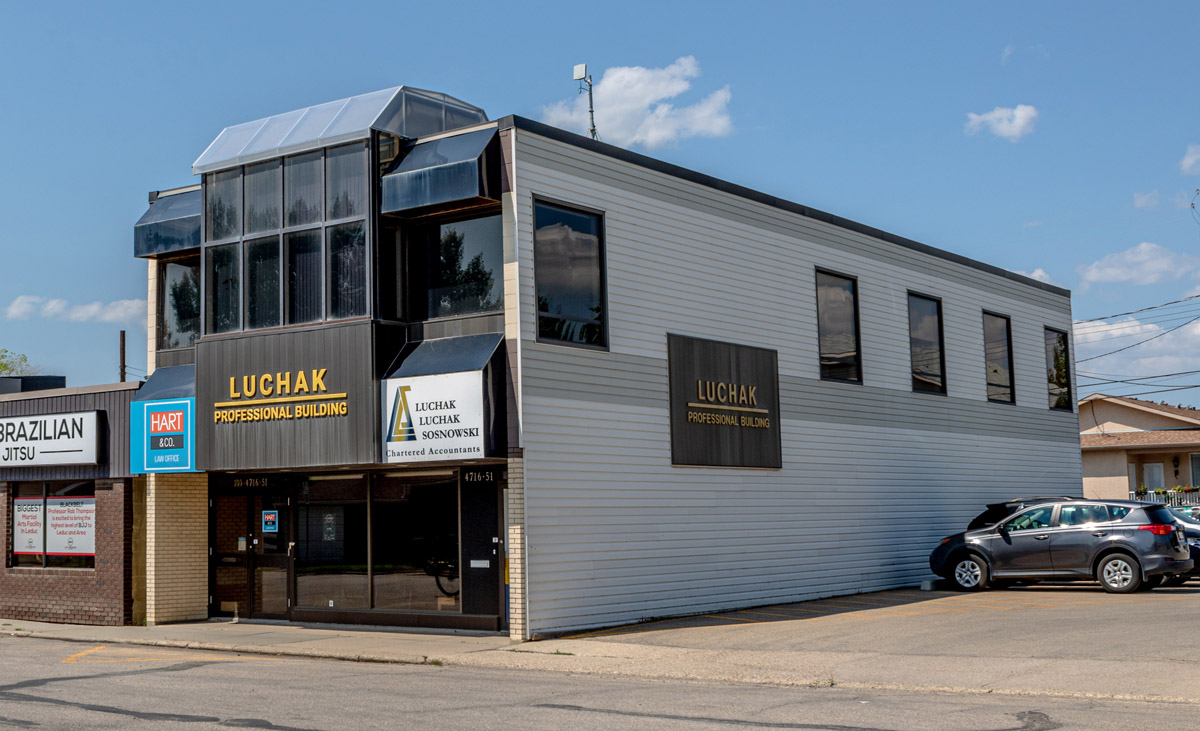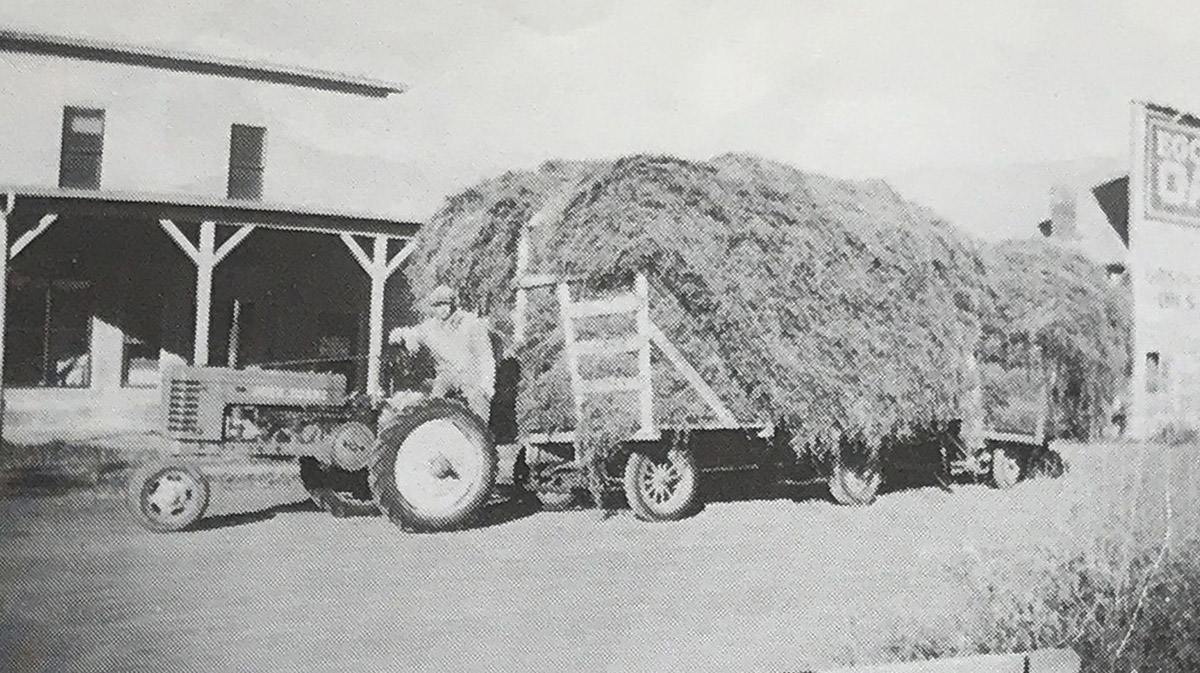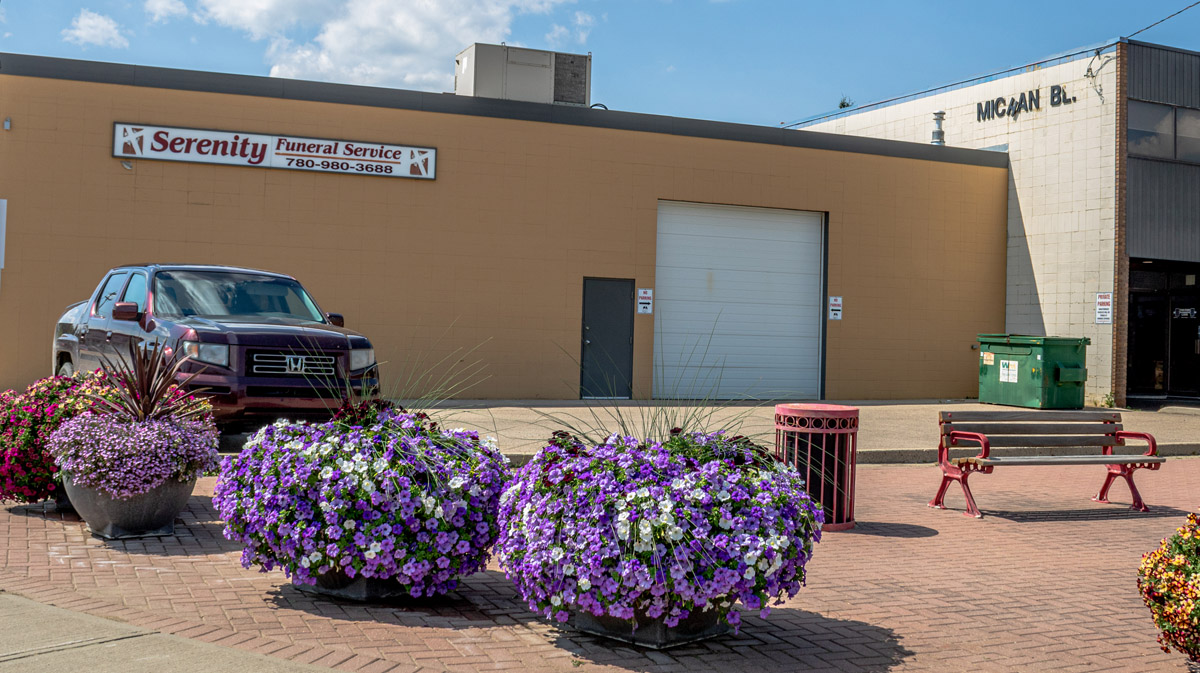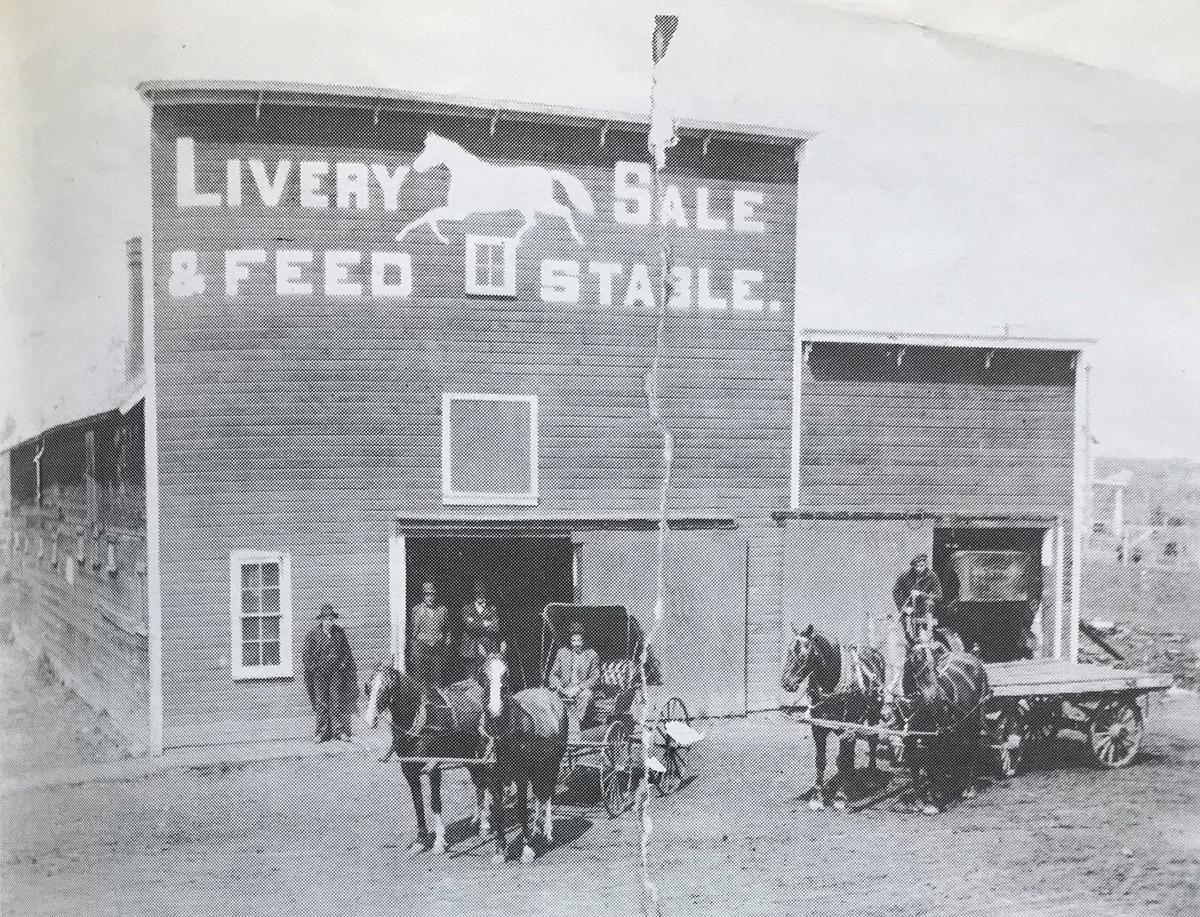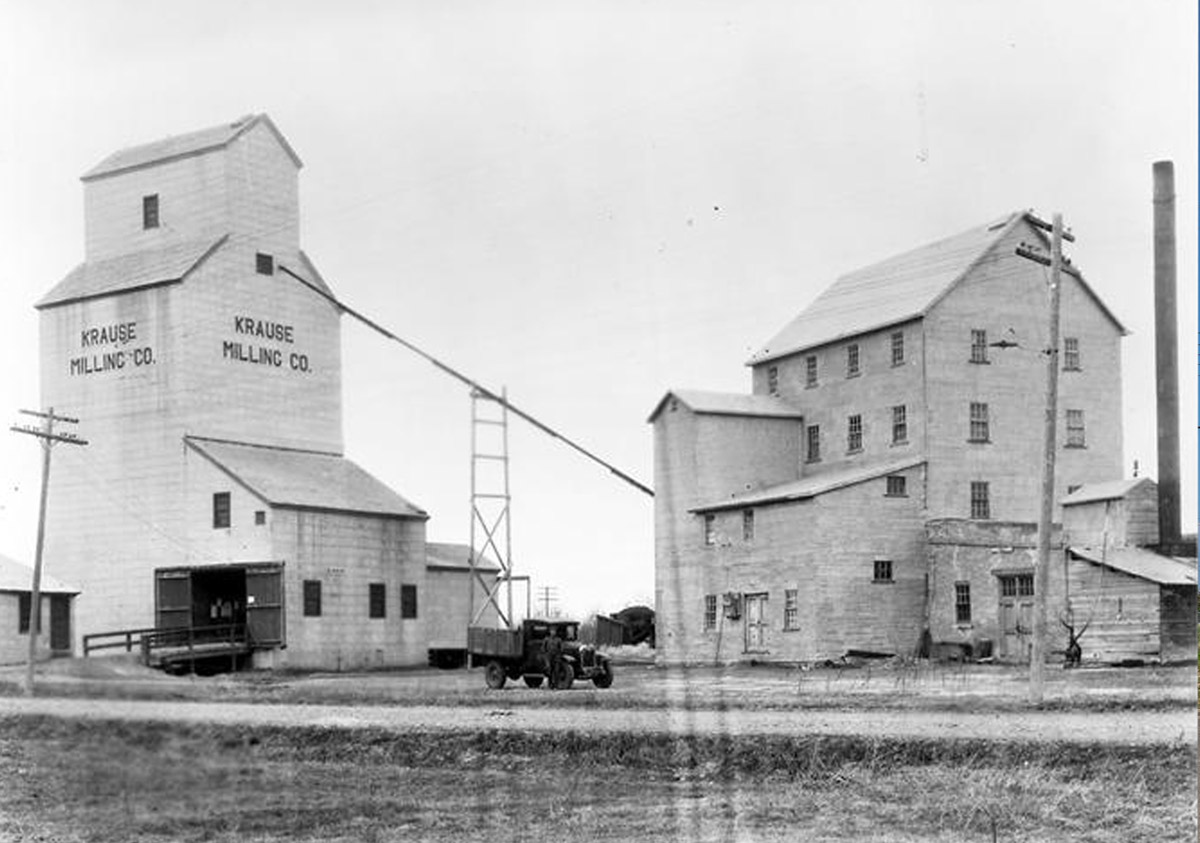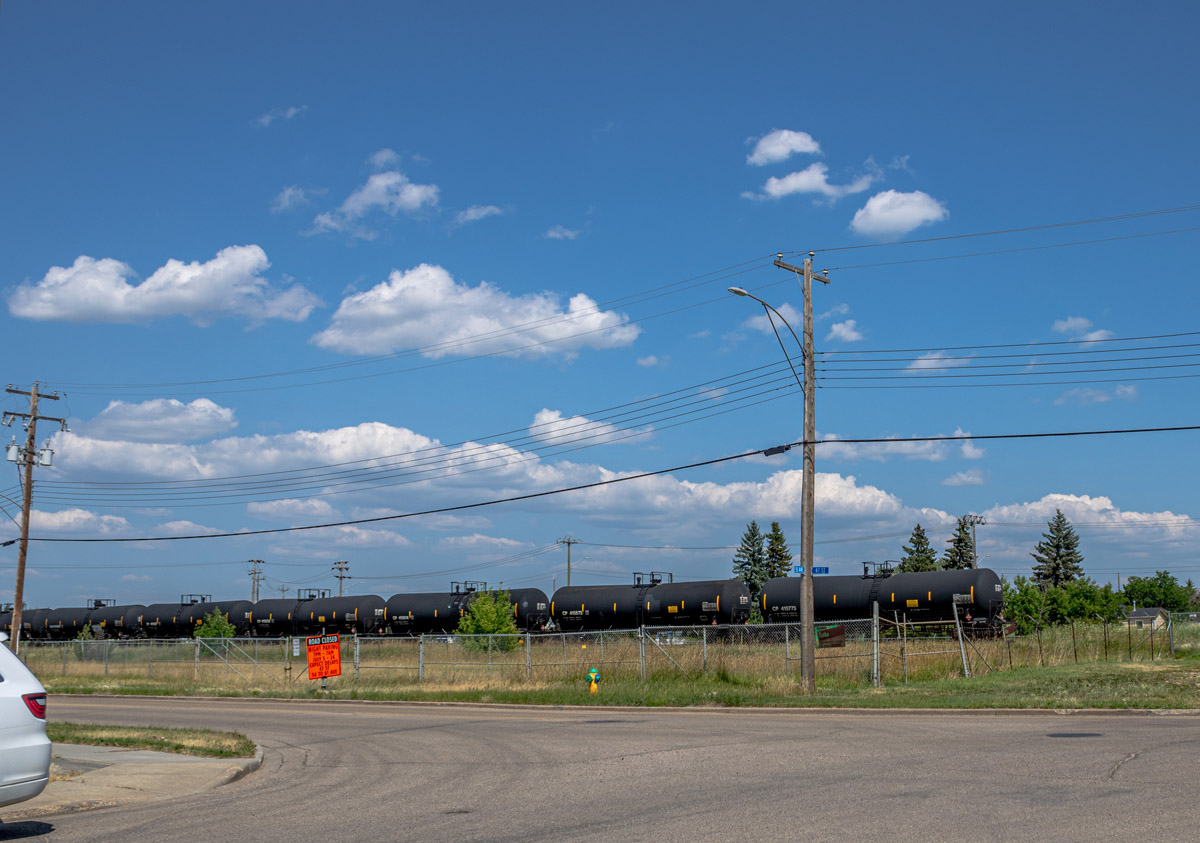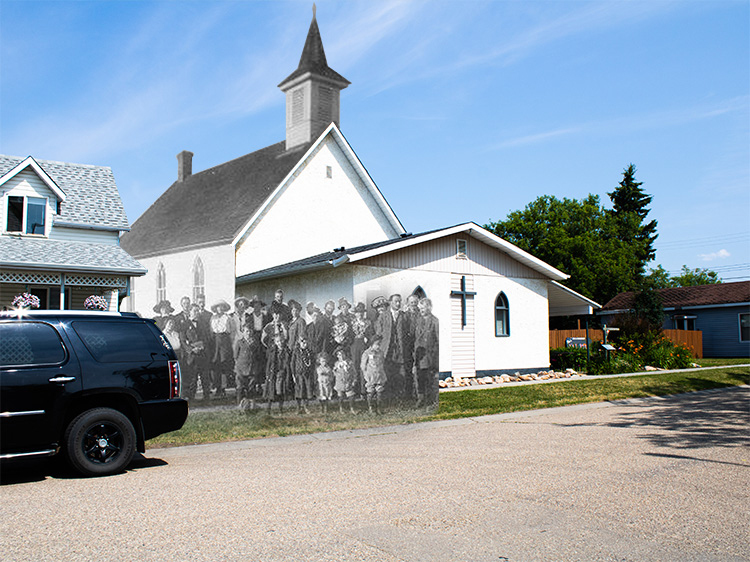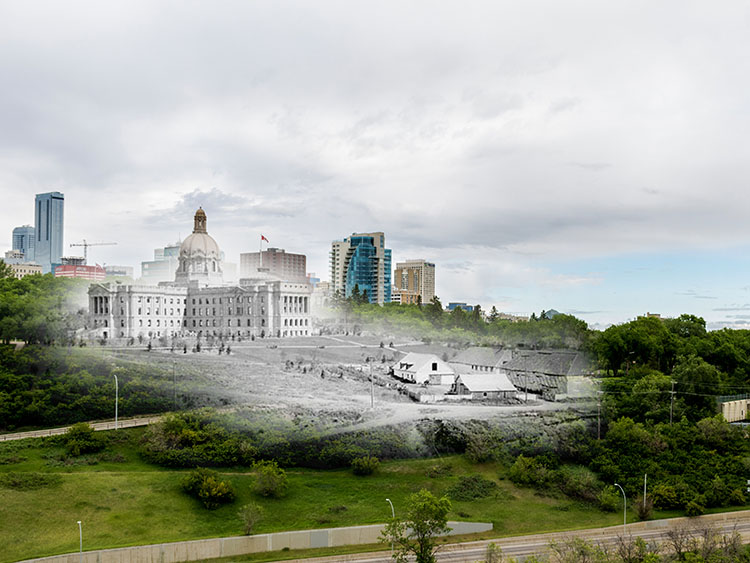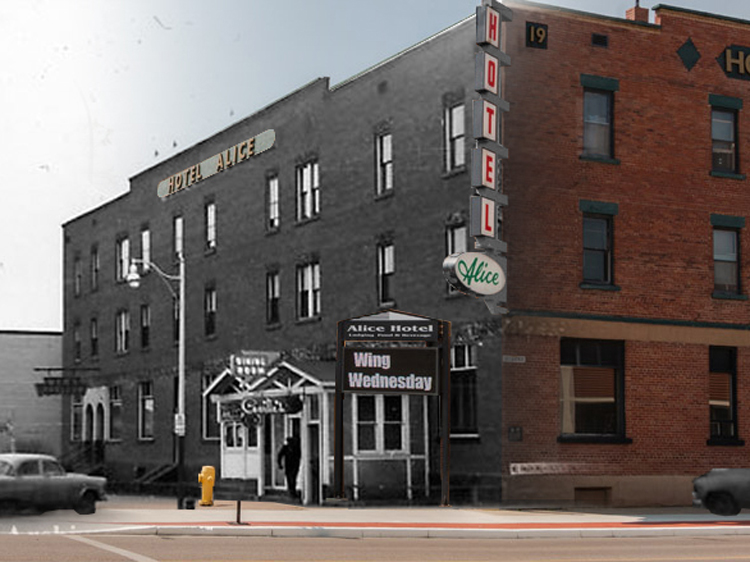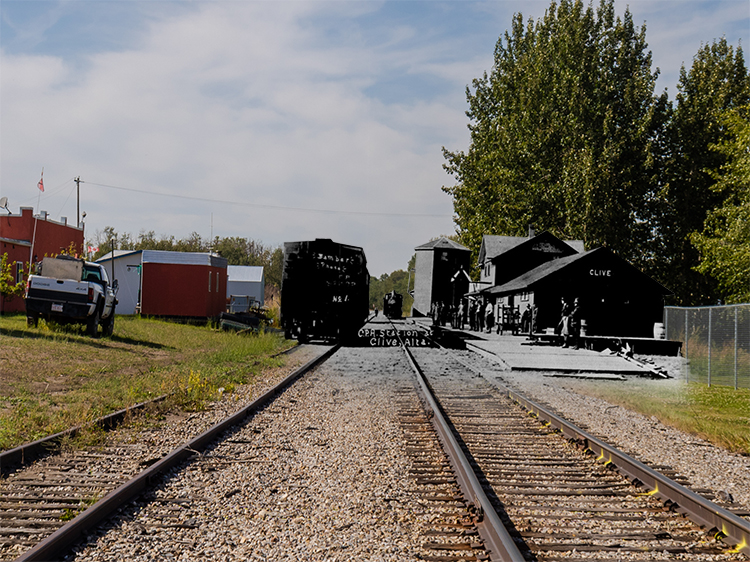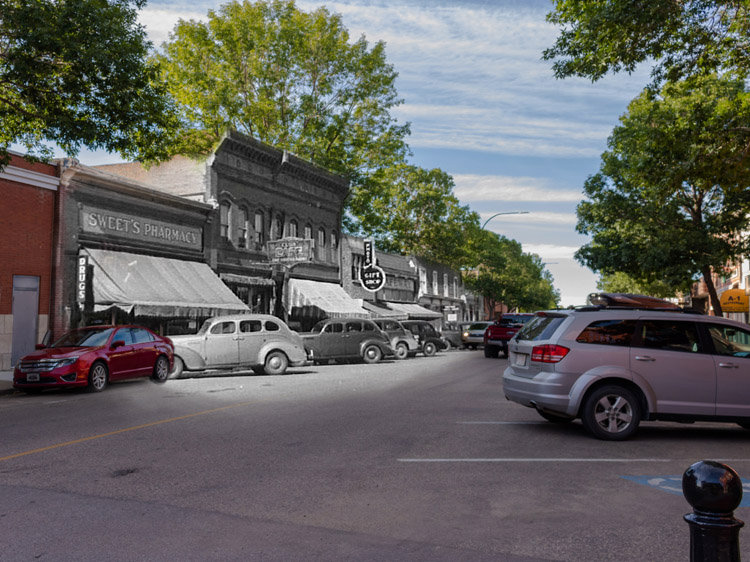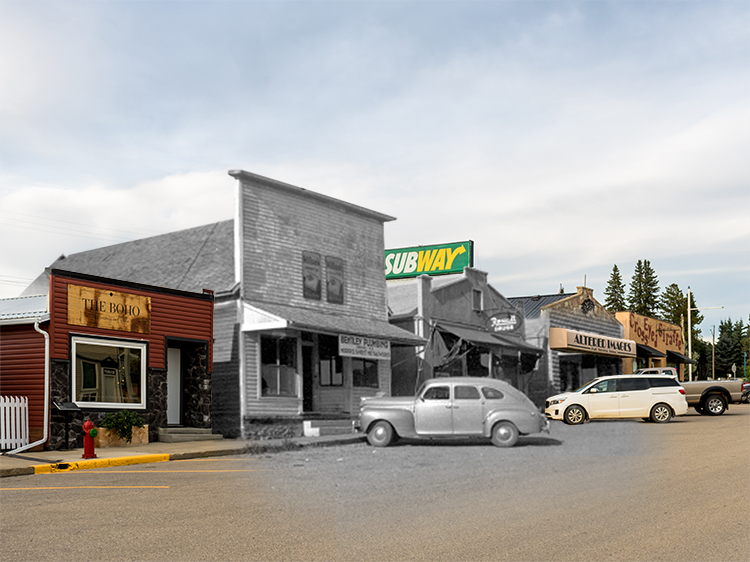Walking Tour
Farms, and Hay, and Dairy Oh My!
Agriculture and Farming in Leduc
By Elyse Abma-Bouma

City of Leduc Photo Collection
The purpose of this tour is to focus on farming and the use of animals and plants, cows and wheat in particular. The Stone Barn is an iconic and scenic location to begin and visualize the farm town that Leduc once was. The route travels up by the lake to the boardwalk making for a beautiful walk before heading into the city to discover where animals and animal byproducts were used in early Leduc. This tour will address themes of immigration, economy and work, technological progress, and showcase Leduc's early labourers of all cultures and genders.
This project was completed in partnership with the City of Leduc.
1. Stone Barn Garden
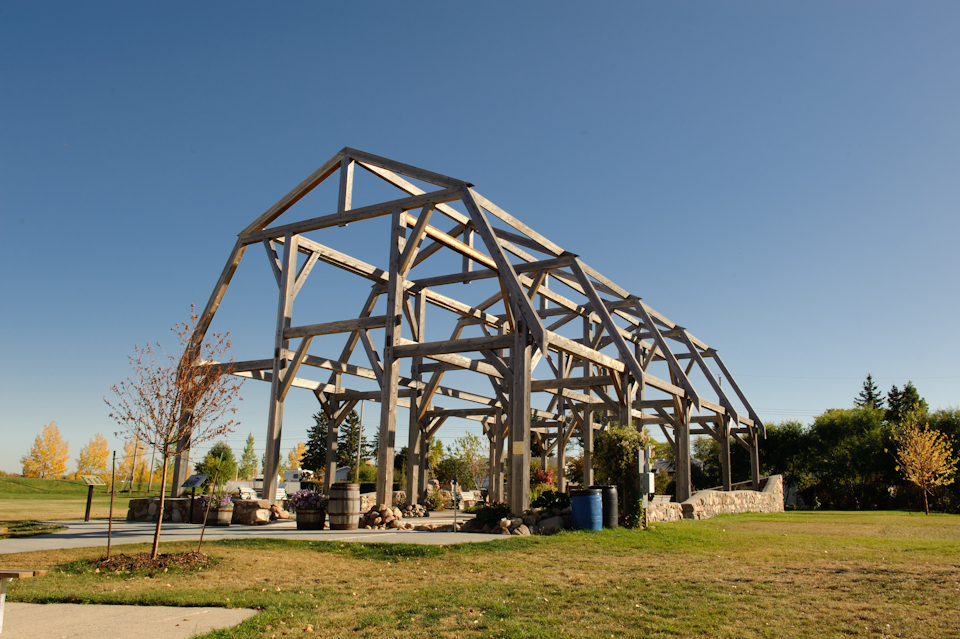
The Stone Barn is the perfect place for us to start our tour about agriculture and farming in and around Leduc. The structure in front of you, while not the original, is where a dairy barn once stood and barns are a key piece of a farming town. Stone Barn Garden is now a Cultural Village that includes a milking shed, landscaped garden, and of course the Stone Barn.
* * *
"The best crop and pasture land in the world!" A poster in Holland pronounced.1 Thousands of others were posted throughout England, Ireland, Holland and Eastern Europe announcing that Canada was a wide open space just waiting for someone to occupy it. 2
Of course the idea of the empty prairie was inherently false. Campaigns such as Sifton's blatantly ignore the Blackfoot, Cree and Dene (among others) who had long occupied the lands that you stand on now. Over the decades since the first Europeans had come to the prairies they had brought with them diseases and poor intentions. First the bison were eviscerated due to over hunting leaving people hungry; Then there was smallpox and other diseases which took too many lives to count. Next the North West Mounted Police came to exert control over Indigenous populations in an effort by the Canadian government to 'settle the west.' Despite Treaty Six, the Blackfoot, Cree and Dene peoples were repeatedly pushed aside from their lands.
Still yet, they remained resilient. To this day Treaty Six Indigenous peoples still live, work and celebrate their languages and traditions on this land. It is with respect and thoughtfulness that we continue, mindful of the complicated nature of this place and the complex relationships that continue on Treaty Six land.3
2. Dry Goods
City of Leduc Photo Collection
ca. 1905-1907
On this spot once stood Leduc's first flour mill. The mill was built by James Finley and Burley Manzer in 1905 to meet the demands of the growing community of Leduc. But the industry was short lived, the flour mill burnt down in 1907 just two years after it opened. Leduc would not be home to another mill until 1911 leaving the people of Leduc to bring their wheat elsewhere.1
* * *
Flour mills were best located near the grain elevators along train tracks. Wheat would be cleaned in the elevator before being sent to the mill. In the mill the grain would be put through rollers called 'breaks' and sifted at each phase. Flour was then bagged, weighed and distributed to dry goods shops and shipped to other Canadian cities.
As we walk through the history of agriculture in Leduc, think about the products that you use everyday that might come from these processes.
3. Farmland
City of Leduc Photo Collection
ca. 1900s
Taken in the early 1900s, this photo shows a woman strolling the bridge over Mill Creek. We can see behind her the marsh area that we can still enjoy today due to conservation efforts. With the City of Leduc behind you look out on the lake. Just beyond the trees lies farmland that was and continues to be a large contributor to the economy in Leduc.1
* * *
The reality, however, was less idyllic than the promise of perfect soil and endless acres would have you believe. Settlers toiled in the sun and snow trying to make the new life promised to them in deceptive campaigns about the endless riches of prairie life.
In this our…first year naturally we had not been able to get a crop in, coming too late, but we…had been busy all summer preparing it for the spring of 1904; breaking and cultivating this virgin land. 4And it could be lonely and isolating too. Not only was the work hard but people had left their families and homes to come to places like Leduc to farm. It was often especially hard on wives whose husbands made the decision to move them to an unfamiliar place.
Oh my friend when one leaves the bright lights, the theatres, the beautiful parks, the wonderful shopping places, and the wonderful churches with their good choirs, grand pipe organs, and famous minister of the Gospel, all to settle down on a farm out where the coyotes yell and the rack rabbits run, and the caw of the crows can be heard, you must surely know that there is some contrast. 5If the land before you could speak I'm sure it would have hundreds of tales to tell. Tales of being tilled and planted, stolen and returned, portioned and divided; but most of all it would tell you that all of those things are what makes space into a place that eventually is called home.
4. Water
City of Leduc Photo Collection
ca. 1900s
Telford Lake, once known as Lake Leduc, is an identifying feature of the city. Leduc used to be referred to as the village on the lake due to its proximity to the body of water before you. This photo, taken by Ernest Brown in the early 1900s, shows the marsh and lake with some boats out for an afternoon paddle on a clear day. Looking out on the lake now it's easy to imaging its recreation potential, but think for a moment about the importance of a body of water like this one to an early and growing community.
* * *
For early settlers in the region water was something at the forefront of people's minds. When a building caught fire water was needed to extinguish it. Too little moisture from the sky meant less crop yield and a tough year. Wetlands meant an abundance of beaver and moose for pelts that could be traded and sold.
Drought has plagued the prairies for as long as farmers have tilled the soil. Data suggests that over forty droughts have plagued Alberta in the last two centuries!2 But perhaps one of the most famous drought is that of the 1930s or the 'dirty thirties' as they are often called. The Western Farm Leader wrote in July of 1936:
When our last issue went to press there was promise of at least an average crop over the greater part of the Province. Today the situation is most seriously changed. Drought accompanied by intense heat and drying winds has taken heavy toll of the growing crops. In the worst districts it is already certain that little grain will be threshed…Deterioration is proceeding at a rapid pace, and every rainless day increases the seriousness of its effects. 3Water could make or break a farming economy. Drought meant little harvest and without the harvest animals were not easily fed and flour was more scarce. As you look out onto Telford Lake think about the effect water has and the power it holds for our agricultural systems.
5. Market Day
City of Leduc Photo Collection
ca. 1890s
A large part of the agricultural economy was the markets. This market in 1907 shows teams of horses unhitched from wagons full of goods for sale. At this particular market in you could purchase butter for twenty cents a pound, oats at the elevator for twenty-three cents a bushel, hides for six cents and chickens for ten.1
* * *
Living as we do on a farm, the size of our family varies. Probably four would be a fair average -- all adults. We have eight rooms. The only woman in the family, I do all the work. This includes washing, scrubbing, butter-making and house cleaning. It is always difficult and usually impossible to get a woman for even a few hours, and I depend upon my own efforts rather than attempt to find help. I buy bread only in an emergency; all other food is prepared at home. Among my household treasures are a washing machine, a bread mixer, a food chopper and a carpet sweeper -- and they are all indispensable. So far as possible I try to conform to this schedule: Monday, washing; Tuesday: ironing; Wednesday: baking; Thursday: sweeping upstairs; Friday: sweeping downstairs; Saturday: baking." 2- Gertrude Stewart Hyde, 1909
Without the unpaid labour of women and children farming would not have been such a success. Though it was mostly men who worked in the fields it was women who brought them food throughout the long harvest days. The mills owned and run by men but the bread baked by a woman. It was not for some years after this market took place that white women would be allowed vote in Canada and still more years before women would be afford equal opportunities to men.
6. Feeding Animals
City of Leduc Photo Collection
The John Flood livery barn is pictured here around 1900 shortly after its construction. Employee Jim Crough stands with five of the stables horses that were rented for use in the community. Livestock were prevalent in Leduc and the small community relied on animals for food, transportation and for farm work. To feed and house animals was a task that shifted and changed over time due to changing demand.1
* * *
Living as we do on a farm, the size of our family varies. Probably four would be a fair average -- all adults. We have eight rooms. The only woman in the family, I do all the work. This includes washing, scrubbing, butter-making and house cleaning. It is always difficult and usually impossible to get a woman for even a few hours, and I depend upon my own efforts rather than attempt to find help. I buy bread only in an emergency; all other food is prepared at home. Among my household treasures are a washing machine, a bread mixer, a food chopper and a carpet sweeper -- and they are all indispensable. So far as possible I try to conform to this schedule: Monday, washing; Tuesday: ironing; Wednesday: baking; Thursday: sweeping upstairs; Friday: sweeping downstairs; Saturday: baking. 2
- Gertrude Stewart Hyde, 1909Without the unpaid labour of women and children farming would not have been such a success. Though it was mostly men who worked in the fields it was women who brought them food throughout the long harvest days. The mills owned and run by men but the bread baked by a woman. It was not for some years after this market took place that white women would be allowed vote in Canada and still more years before women would be afford equal opportunities to men.
7. Butchers
City of Leduc Photo Collection
ca. 1926 - 1940.
Built by Herb Reed in 1926 the Herb Reed Butcher and Meat Market building is emblematic of the boom time in Leduc. Built in the prairie classical style we can see the brick facade and sign band which are features of the style.1
Butchers are an important aspect of local life. Butchering one's own meat is a messy endeavor and requires space and tools that many did not have. Being able to bring livestock to a local butcher was an essential service.
* * *
Even Leduc's famous photographer Harry Bamber dabbled in the art of the butcher. Though his love for photography was evident he saw no immediate future in the industry. When Harry was eighteen he left his family's farm and worked for Gallagher-Hull Meat Packing Company in Edmonton. It was while he worked as a butcher that he was able to continue honing his craft as a photographer and eventually open his own studio and photograph Leduc through his own eyes.3
While most residents of Leduc did not become a photographer after a visit to the butcher you would be hard-pressed to find one who did not benefit from a butcher's work.
8. Grocery Stores
ca. 1920
The Taylor & Essery Grocery Store, shown here in 1920, opened in 1914 and provided Leduc with groceries and produce for nearly forty years. In 1941 owners R. D. Essery and Laudy Adamic sold Essery Grocery to Albert Wright and it became Wright's Grocery.
* * *
Grocery stores also looked much different than they do today. Rather than browsing isles and shelving and filling a cart, customers would stand at the counter and ask the clerk to bring the desired goods to the counter from the back shelf. 1
9. Dairies
1912
The Edmonton City Dairy Leduc Branch, pictured here in 1912, was the first dairy to sell bottled milk in the area. The Edmonton City Dairy began in Edmonton in 1906 and rapidly expanded.
"Buy your Milk and Cream from a firm that is in position to supply you, not only regularly, but with milk or quality that is beyond question, the best in Edmonton. We have the largest and best equipped Dairy, Creamery and Ice Cream Plant in the West."1
The dairy boasted only pasteurized products and consistent delivery with the best products including ice cream.
* * *
Buy your Milk and Cream from a firm that is in position to supply you, not only regularly, but with milk or quality that is beyond question, the best in Edmonton. We have the largest and best equipped Dairy, Creamery and Ice Cream Plant in the West. 1The dairy boasted only pasteurized products and consistent delivery with the best products including ice cream.
Creameries quickly became a building block of the community. Dairy was a popular farming choice because of its renewable nature.
For instance (for example), a settler arrives here [with enough resources] to [build] a small house on this 160-acre homestead..., with horses, a plough (a tool used to prepare soil for planting crops) and harrow [a tool for breaking up and smoothing out soil], and with enough of seed to plant a few acres. Then, if he has a wife, and $100 left, let him buy two cows; if more money... more cows — say five cows the first year. From these he will be able to make butter daily during five months, worth in our market 25 cents…. This will support himself and wife. The milk will also feed three calves and a couple of pigs. Now, it must be remembered that the care of these should not prevent him from cultivating [growing] a good garden and attending to a goodly (large) number of acres (hectares) of crops besides. And it must be also remembered... that no matter how favourable (pleasant) the season may be, the garden and the cultivated acres may be a failure, but neither hail-storm nor frost affect the returns (payments) from properly attended milk cows. [These activities will result in] cooperative dairy farming (when farmers work together and combine their resources), when the creamery (a place where dairy products like butter and cheese are made) will be established in the town. In this creamery, a... butter-maker... will produce from the best cream of Alberta the best creamery butter... in the world." 2
-- James Ruby November 17, 1888It was premier Alexander Rutherford who spurred on the creamery initiative. Beginning in 1906 Rutherford started to invest much of his time into figuring out how to better support farming in the province. In 1906 Rutherford's efforts and investment led to an expansion of creameries in the province and increased Alberta's butter output by $100,000 in 1907. With new creameries popping up more dairy producers had better access to their distribution services benefiting Leduc and Alberta in general.3
10. Transportation Technology
City of Leduc Photo Collection
ca. 1900s
Taken by Leduc's own Harry Bamber, this photo looking east down Main Street we can see a view very different from today's. The dirt streets, horse-drawn wagons and wooden facades have been replaced with pavement, cars and buildings of brick and aluminum.
* * *
New decades brought advanced technology and motorized vehicles were becoming increasingly popular. Cars and tractors swept Leduc off its feet making labor intensive tasks quicker and easier. But the debate of horse-power vs motor-power was still alive and well:
Since the farm tractor has actually invaded a field of operations at one time held almost exclusively by horses, it might be well to inquire wherein horse power was deficient, that other power found an opportunity to establish itself. An examination of the development of the use of tractors in farming operations reveals this very gratifying and significant fact: That the tractor found a place because of the scarcity of horses, the lack of volume of horse power, not the lack of its quality. 1We now know that the tractor won out in the end. The convenience of machinery as advances continued to be made was undeniable. It's hard to imagine a contest between horse and tractor was ever the subject of headlines but the lure of change is often met with resistance and traditional ways of doing things do not always go easily.
11. Restaurants & Hotels
ca. 1950s
Waldorf Hotel was built in 1910 and burned down in 1940. The Waldorf Hotel was started by Robert Taylor Telford in the 1890s as a stopping house. The stopping house was then expanded into a hotel. Over the years the hotel would see many more expansions under a variety of owners.1
* * *
Cafes and restaurants were among the first located on main street. After 1923, provincial liquor regulations required that every hotel with a liquor license have an eating place…They had a direct utilitarian purpose in serving food to the many commercial travellers, to farmers and their families in town for the day, and to local people without cooking facilities.2
With a liquor license and local cuisine hot and ready, the Waldorf opened its doors daily to farmers, business owners, preachers, doctors and all other labourers to get their fill of Mrs. Aicher's renown cooking. And, at the end of the night, all would go home well-fed thanks to the efforts of farms all around Leduc.
12. The U.F.A.
City of Leduc Photo Collection
Begun in 1909 by a group of Edmonton farmers, the UFA had a strong presence in Leduc and Alberta as a whole. The Leduc chapter building that we can see here was started in 1916 and served farmers far and wide with hardware, harnesses and equipment. The machinery on the left of the building was rented out to farmers who could not afford or store their own.1
* * *
The UFWA members were instrumental in bringing women's issues to the forefront. Farm women fought that the same homestead privileges afforded to men should be afforded to women as well, and in 1919 the resolution was passed reading:
Whereas women are taxed for the support of the Government that same as men, therefore we feel that any natural resources that the Government has to put at the disposal of its citizens should be free to all, irrespective of sex, and we most respectfully ask that Homesteading privileges be extended to women on an equality with men. 3Though the United Farm Women of Alberta made way for many women to experience equality on the prairies many were left behind and harmed by their philosophies as well. UFA and UFWA activities and activism was meant for those Canadians of European ancestry and discriminated based on race. Both organizations were strong supporters of the eugenics movement in Alberta that sought to sterilize those they deemed "undesirable" and prevent them from having children. These movements disproportionately affected Indigenous women and First Nations are still fighting ideas set up by the UFA and UFWA today.4
13. Immigration and Farming
City of Leduc Photo Collection
ca. 1910s
Built prior to 1903 this restaurant/ boarding house/ cafe was owned and operated by Ernest Lake Sr. and his family. The Lake family lived in the building as well before selling to baker Joe Reed in 1910. In this photo we can see Ernest holding his daughter Louisa with his son Ernest Jr. sitting on the railing opposite them. The building was demolished by Joe Reed shortly after the first world war and today is home to a professional building.
* * *
I think a stalwart peasant in a sheep-skin coat, born on the soil whose forefathers have been farmers for ten generations, with a stout wife and a half dozen children is good quality, I am indifferent as to whether or not he is British born. 3But the prairie immigrant's life was a hard one. Many were deceived into living on rough land that took years of work to make profitable. Others found themselves at immigration halls with no idea where to go next and not able to speak English. Settler Gertrude Watt once said:
I no longer utter mental protest against the prairie as a final resting place. Our western life is too real, too vital to waste time in gloomy speculation. It is enough that you are alive and can take your chances in the great future that lies just at hand. 4Scarcely did early agricultural immigrants have time to consider their dire circumstances, but simply live and work and remain alive.
14. Hauling Hay
City of Leduc Photo Collection
ca. 1950
Pictured here is Art Moberg circa 1950 posing with his haul of hay for his herd. Art and Lena Moberg owned Morberg's Dairy which supplied much of Leduc with its dairy products. Mr. Moberg is stopped just beside the UFA building, likely to use their scales outfront to measure the load.1
* * *
But what is hay other than a large round bale that feeds cows or horses? Hay is a crop, often alfalfa, that is harvested and dried in the sun before being collected and stored to feed animals throughout the winter and when there is no pasture for them.2
In the early days of Leduc harvesting was done by machinery pulled by horses or powered by steam. Tractors only made an appearance after 1905 and even then not all farmers could afford power machinery.3
I know that the average farmer lets the hay stand too long before he cuts it. If you want tht ebay that is going to be the primest kind of food for a dairy cow or a horse or a sheep, cut it a few days before you think it is ready. I know what you think it should be like when it is ready, and I do not quite agree with you…Cut you clover before you see a dead head and cut you timothy when it is in blossom…We think because a certain quantity of hay weighs 50 pounds that, therefore, we have 50 pounds of feed value. If that hay had been cut when it was only 45 pounds we would have 10 or 15 more pounds of food value. 4After harvest a drying hay would be stored in barns or baled and stored (for better stacking and drying). Farmers continued to test different crops and methods to make the best feed for their livestock at the best prices possible.
15. Seed Cleaning
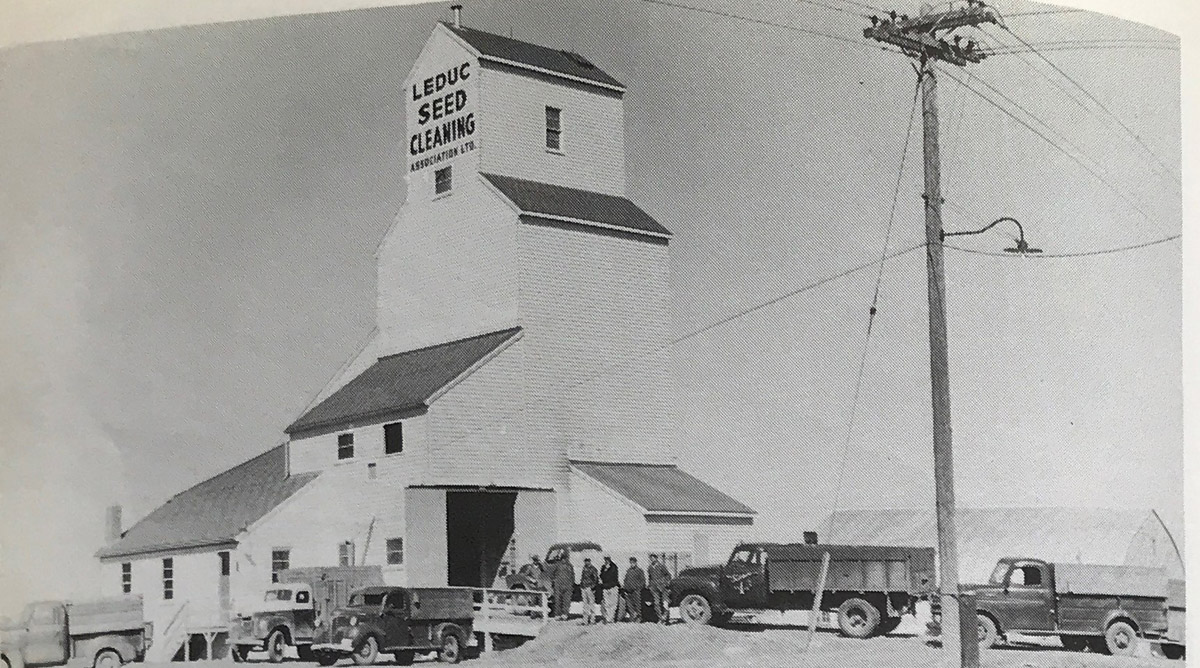
ca. 1950s
The Leduc Seed Cleaning Association opened its doors in 1955. The start of group and its efforts to improve crop quality in Leduc was celebrated in an opening ceremony attended by the Minister of Agriculture.1
* * *
Seed has not only to be cleaned but tested for germination. Goo crops do not come from bad seed, it is empasized. The horses' feet have to be fixed and the diet fortified for the heavy work ahead. Emphasis is placed on all these things, which are a commonplace to the farmer, because so much depends on the coming season's crops in Canada. The world's production of cereals and other foods is still lagging behind its requirements, and Canada is one of the surplus production countries to which the eyes of the world are turned. 4As farmers saw their crops improve, seed cleaning plants became busier:
"Seed Cleaning Plant…is now operating twenty-four hours a day. The manager reports that 1,500 bushels of grain are being cleaned to a Seed Grade Standard daily. Every kernel of oats we can clean will be used for seed." 5Today technology has advanced to a point that seed cleaning is an integral part of farming life. While it once might have been a luxury or controversial to clean seeds, it has become necessary and expected.
16. Livery Stables
City of Leduc Photo Collection
ca. 1900s
Ed Southwick's Livery Stable was built just prior to 1900 making it one of Leduc's earlier buildings. In front of the stables pose Eric Moberg and Jim Willies with their buggies and horses. If you look to the right hand side of the photo we can see an automobile parked inside the livery stable showing the turn in transportation technology when this photo was taken.1
* * *
Instead of cars, livery stables kept livestock and wagons providing a necessary service to small communities like Leduc. In 1911 Leduc was home to three livery stables exhibiting the need for such a business in a growing community.2
Advertisements often illustrated the fanciness of their wagons and carriages or the quality of the horses:
"Phone No. 32 for light livery -- Stylish horses and nobby rigs. Feed Stables in Connection. Give us a trial." 3Livery stables also served as a place to board animals, especially in the cold winter months. If a farmer came on her monthly trip into town for supplies only to find that there was a thunderstorm headed her way, she might pay the livery to keep her horse for the day while grabbing dinner at the Waldorf hotel.4
17. Storing and Shipping Grain
City of Leduc Photo Collection
ca. 1920s
Built in the 1920s Krause's flour mill and grain elevator were the skyscraper of Leduc. Krause built the elevator next to the mill to optimize his business with ease of transport for the grain from one building to the next. Owning both things made sense for streamlining the process and maintaining product quality.1
* * *
The elevator that used to stand here was part of a larger operation in Leduc and Alberta. The Krause company owned elevators and mills in both Radway and Leduc as well as a creamery or two. This conglomeration goes to show how each farm goods entity is dependent on another. If one runs a mill, why not have an elevator nearby? And if one one has delivery transportation for grain goods why not expand into dairy goods and have the creamery too?
"[People] who came to prairie Canada to claim homesteads to support their families. Many succeeded, others were thwarted…Prairie Canada was crafted as a colony of the British Empire, and hopes were high for its destiny as the brightest agricultural jewel in the imperial diadem… [they] were to transplant and cultivate not only the crops that would make the prairies the breadbasket of the Empire: here was a "sparsely-peopled or savage-haunted" place where they could plant, grow and prune a "dominating race." 2Those who settled and farmed around Leduc worked hard, each story is different and significant. The broader implications of the settler agriculture story should not be lost in the details of grain elevators and creameries but help us to build a bigger picture about the prairies and who has called this place home for thousands of years, decades, dozens or just a couple of days. Each of us owes it to the larger story to try to understand and respect each narrative that we hear about this place and those important to it.
Endnotes
1. Stone Barn Garden
1. Rasmussen, Linda & Lorna; Wheeler, Anne; Savage, Candace, "A Harvest Yet to Reap" The Women's Press (Toronto), 1979. 17.
2. Hall, David J.. "Sir Clifford Sifton." The Canadian Encyclopedia. Historica Canada. Article published January 22, 2008; Last Edited April 12, 2021.
3. Filice, Michelle. "Treaty 6." The Canadian Encyclopedia. Historica Canada. Article published October 11, 2016; Last Edited October 11, 2016.
2. Dry Goods
1. "Leduc Reflections" 1981.
2. RETROactive: Exploring Alberta's Past, "Radway's Once Thriving Flour Mill," October 9, 2014, online.
3. Paul W. Brennan, "Flour Milling," The Canadian Encylopedia, March 4, 2015, online.
3. Farmland
1. "Leduc Reflections"
2. Alberta Milk, "Change with the Times," (2017), 26.
3. Chandler, Graham "Selling the Prairie Good Life" September 7, 2016.
4. "A Harvest Yet to Reap," 32.
5. "A Harvest Yes to Reap," 32.
4. Water
1. "Traditional Stories and Creation Stories" HistoryMuseum.ca https://www.historymuseum.ca/history-hall/traditional-and-creation-stories/
2. "History of Drought in Alberta" Alberta Water Portal Society, December 17, 2014. https://albertawater.com/history-of-drought-in-alberta
3. The Western Farm Leader, July 17, 1936. Page 4.
5. Market Day
1. "Leduc Reflections"
2. "A Harvest Yet to Reap," 44.
6. Feeding Animals
1. "Leduc Reflections"
2. "Raising Feed" Wainwright Star, February 5, 1919. Page 3.
3. "Cattle Feeding in Alberta" https://cattlefeeders.ca/history-in-alberta/
4. "For better assessment of feed crops" The Farm and Ranch Review, August 1, 1959. Page 8.
7. Butchers
1. "Herb Reed Butcher and Meat Market," City of Leduc Downtown Heritage Inventory, 24.
2. "Leduc: Then & Now" 32.
3. "Leduc: Then & Now" 19-20.
8. Grocery Stores
1. "Leduc Reflections"
9. Dairies
1. "Milk & Cream" The Gateway, February 1, 1913.
2. "Change with the Times" https://albertamilk.com/wp-content/uploads/2017/08/Change-with-the-Times-LearningSources.pdf
3. Klassen, Henry C. "A Business History of Alberta" University of Calgary Press (1999). 72-73.
10. Transportation Technology
1. "Horse of Tractor Power" The Grain Grower's Guide, March 15 1916. Page 7.
11. Restaurants & Hotels
1. "Then & Now" 54-56
2. Wetherell, Donald G. and Kmet, Irene R.A. Town Life. The University of Alberta Press (1995). 227.
12. The U.F.A.
1. "Leduc Reflections"(1981)
2. Langford, Nanci "United Farm Women of Alberta" Encyclopedia of the Great Plains (2011). http://plainshumanities.unl.edu/encyclopedia/doc/egp.gen.038
3. Carter, Sarah Imperial Plots. University of Manitoba Press (2016). 349.
4. Ball, N. "United Farm Women of Alberta (UFWA)". Eugenics Archive (September 14, 2013). http://eugenicsarchive.ca/discover/tree/5233ca4d5c2ec50000000099
13. Immigration and Farming
1. "Leduc Reflections" (1981)
2. Erica Gagnon, "Settling the West." Canadian Museum of Immigration at Pier 21. https://pier21.ca/research/immigration-history/settling-the-west-immigration-to-the-prairies-from-1867-to-1914
3. "Canada Opens Its Door" CBC Learning. https://www.cbc.ca/history/EPISCONTENTSE1EP11CH3PA1LE.html
4. Rasmussen, Linda & Lorna; Wheeler, Anne; Savage, Candace, "A Harvest Yet to Reap" The Women's Press (Toronto), 1979. 60.
14. Hauling Hay
1. "Leduc Reflections" (1981)
2. "Hay" Living History Farms. https://www.lhf.org/learning-fields/crops/hay/#:~:text=The%20first%20hay%20baling%20equipment%20was%20invented%20in%20the%20late%201800s.&text=Hay%20was%20carried%20by%20hand,the%20hay%20from%20the%20ground.
3. Skrinjar, Janelle "Hay History" Farm and Dairy (August 24, 2006) https://www.farmanddairy.com/news/hay-history/451.html
4. "Common Sense Cow Feeding" The Grain Grower's Guide (September 22, 1915)
15. Seed Cleaning
1. "Leduc Reflections" (1981)
2. Geddes, Geof "Alberta's First Seed Plant Doesn't Act Its Age," Alberta Seed Guide (January 12, 2018)
3. MacArthur, Mary "Seed Cleaning Plants Play a Quiet but Important Role" The Western Producer (February 7, 2014)
4. "Urge Planning Early of Spring Farm Operations" Western Farm Leader (January 23, 1948)
5. "Seed Cleaning Plant Going 24 Hours A Day" St. Albert Gazette (November 24, 1950)
16. Livery Stables
1. "Leduc Reflections" (1981)
2. "Steady Growth Shown in Leduc" The Edmonton Bulletin (February 7, 1911)
3. Red Deer News (January 13, 1909) Page 4.
4. With, Farley "A Look Back at a Few of Those Pioneer Livery Stables." Kootenai Brown Pioneer Village. https://www.kootenaibrown.ca/transportation-roads-rails/a-look-back-at-a-few-of-those-pioneer-livery-stables
17. Storing and Shipping Grain
1. "Krause Milling and Co." Alberta Register of Historic Places. https://hermis.alberta.ca/ARHP/Details.aspx?DeptID=1&ObjectID=4665-0902
2. Carter, Sarah Imperial Plots. University of Manitoba Press (2016). 5.




